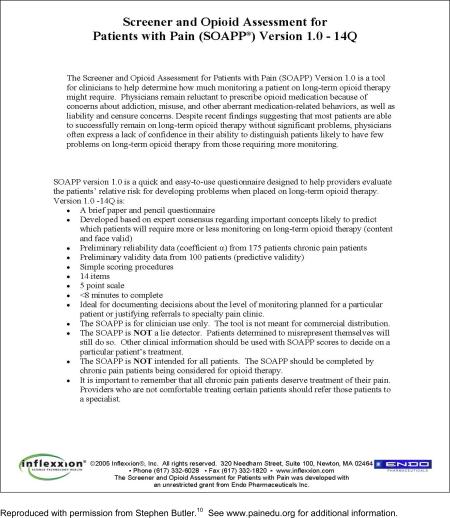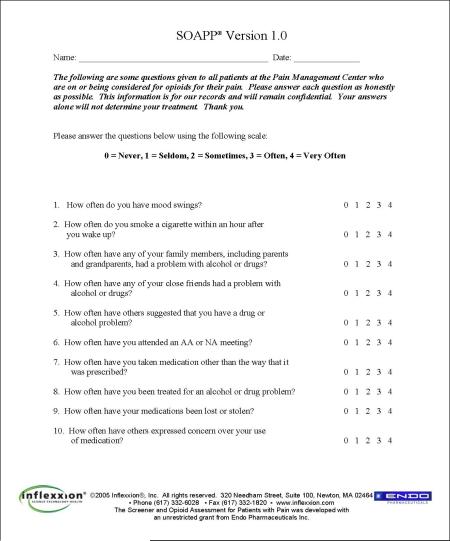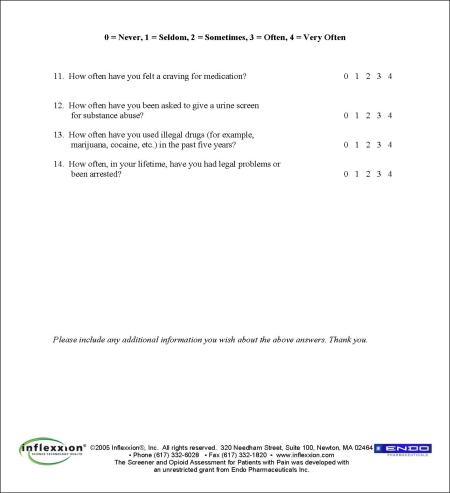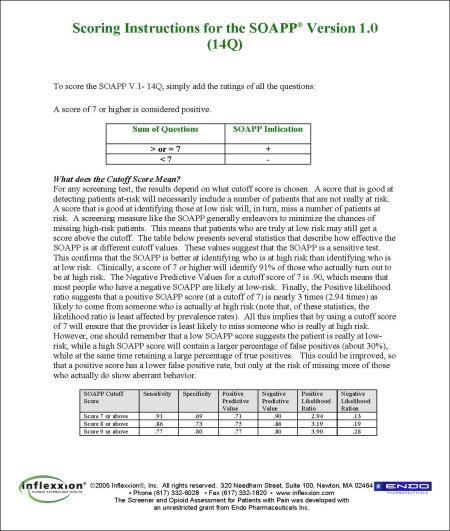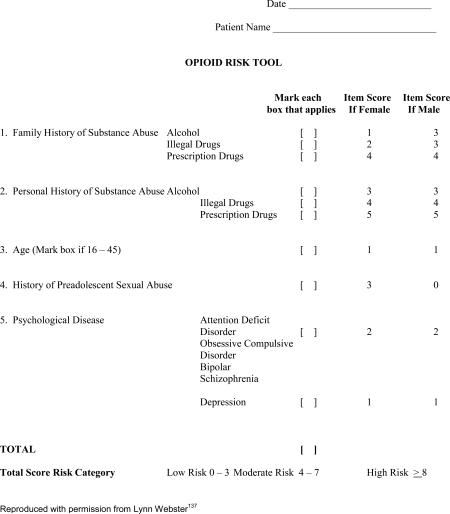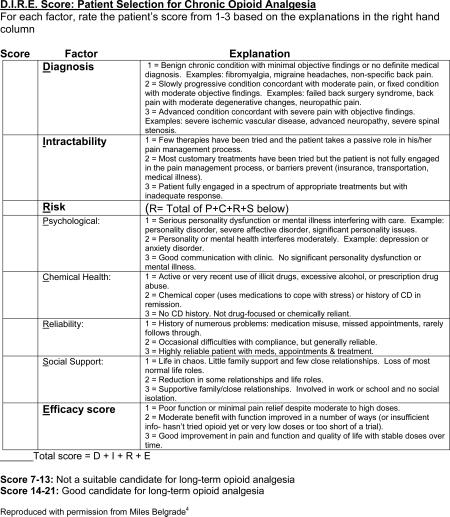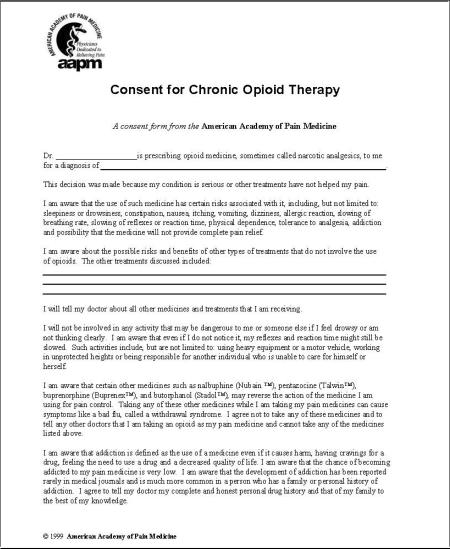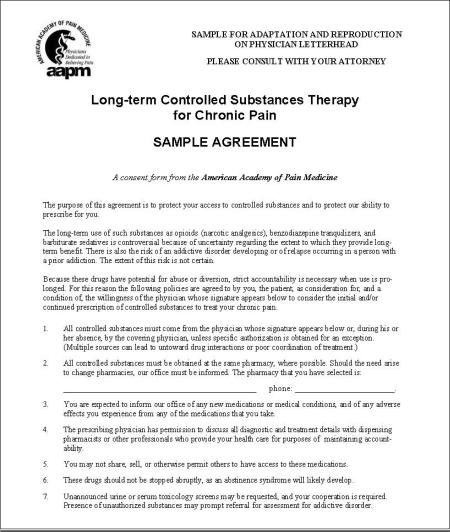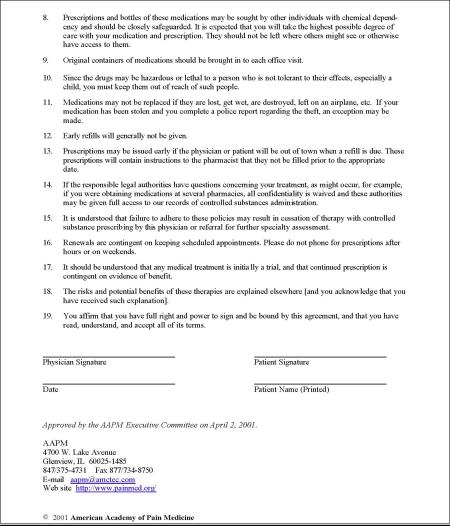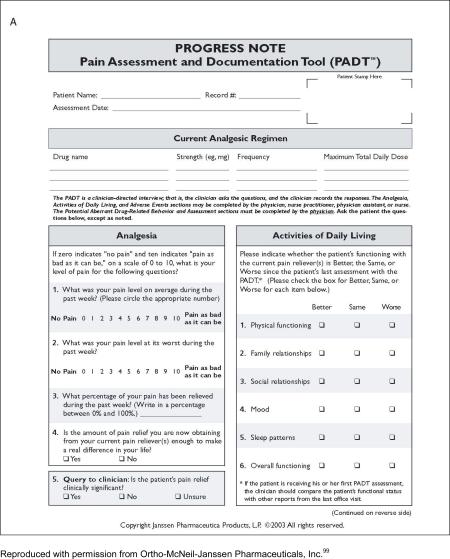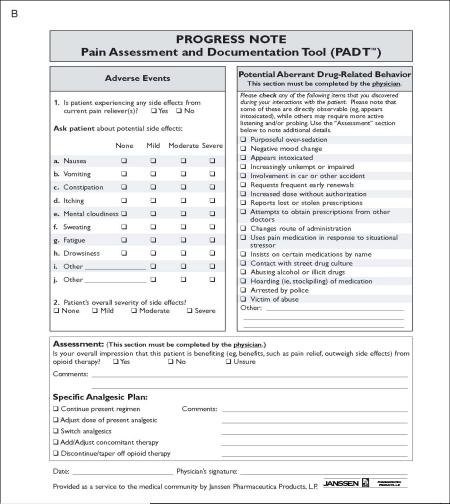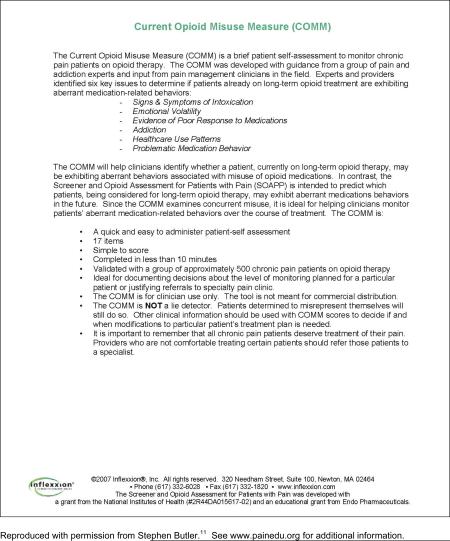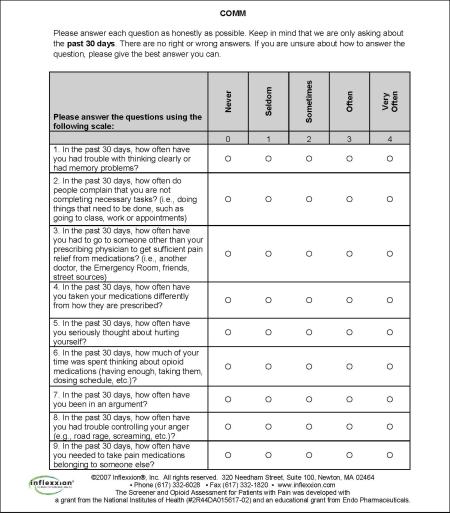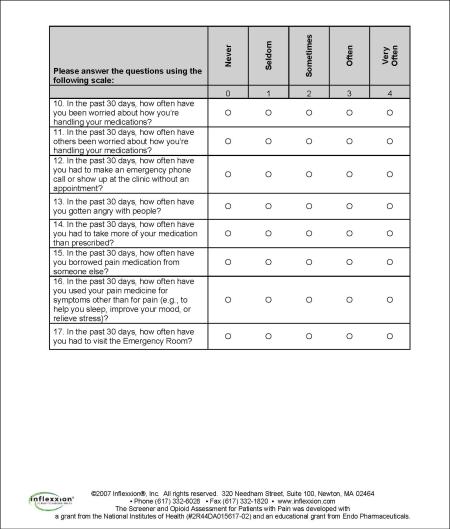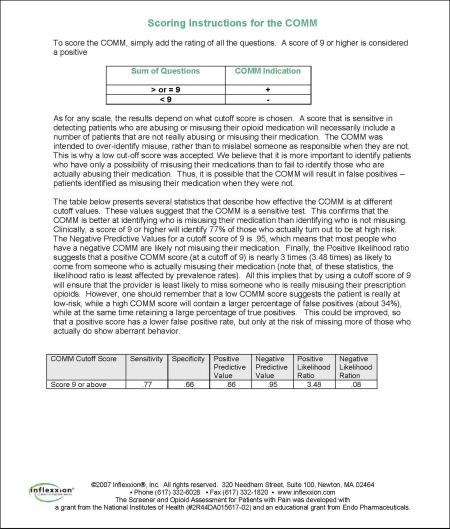Abstract
Use of chronic opioid therapy for chronic noncancer pain has increased substantially. The American Pain Society and the American Academy of Pain Medicine commissioned a systematic review of the evidence on chronic opioid therapy for chronic noncancer pain and convened a multidisciplinary expert panel to review the evidence and formulate recommendations. Although evidence is limited, the expert panel concluded that chronic opioid therapy can be an effective therapy for carefully selected and monitored patients with chronic noncancer pain. However, opioids are also associated with potentially serious harms, including opioid-related adverse effects and outcomes related to the abuse potential of opioids. The recommendations presented in this document provide guidance on patient selection and risk stratification; informed consent and opioid management plans; initiation and titration of chronic opioid therapy; use of methadone; monitoring of patients on chronic opioid therapy; dose escalations, high-dose opioid therapy, opioid rotation, and indications for discontinuation of therapy; prevention and management of opioid-related adverse effects; driving and work safety; identifying a medical home and when to obtain consultation; management of breakthrough pain; chronic opioid therapy in pregnancy; and opioid-related polices. Perspective: Safe and effective chronic opioid therapy for chronic noncancer pain requires clinical skills and knowledge in both the principles of opioid prescribing and on the assessment and management of risks associated with opioid abuse, addiction, and diversion. Although evidence is limited in many areas related to use of opioids for chronic noncancer pain, this guideline provides recommendations developed by a multidisciplinary expert panel following a systematic review of the evidence.
Keywords: clinical practice guideline, opioids, opioid analgesics, risk assessment, monitoring, chronic pain
Introduction
Opioid analgesics are widely accepted for the treatment of severe acute pain and chronic pain related to active cancer or at the end of life. In contrast, the use of chronic opioid therapy (COT, see Glossary) to treat other types of chronic pain remains controversial. Chronic pain is defined by the International Association for the Study of Pain as “pain that persists beyond normal tissue healing time, which is assumed to be three months.” 59 Chronic pain may occur in the context of numerous diseases and syndromes.9, 51, 133 For the purposes of this guideline, all chronic pain disorders outside of cancer pain or pain at end of life are collectively labeled “chronic non-cancer pain” (CNCP). CNCP conditions, including common conditions such as back pain, osteoarthritis, fibromyalgia, and headache, are extremely prevalent and account for very large costs. For back pain alone, total health care expenditures in 2004 and 2005 were estimated at $85 to $100 billion.76 CNCP is a leading cause of disability16, 127 and can have deleterious effects on ability to work, functional status and other quality of life domains.
There are numerous treatments for CNCP and a comprehensive assessment is needed in every case to guide therapeutic decision making. Some patients with CNCP are appropriate for focused therapy with a small number of modalities. Patients with more complex cases, including those with disabling CNCP, tend to experience better outcomes if they are managed using a comprehensive approach that integrates strategies to improve pain with those that address the functional impairment and psychosocial factors that are often associated with CNCP.89 Whether the plan of care is limited or is designed to be more comprehensive, opioid therapy may be a useful component of the management plan.30, 131 However, the selection of patients for an opioid trial, and decisions about chronic opioid therapy (COT), must weigh potential benefits of opioids against the risk of significant harms, including a wide range of adverse effects as well as adverse outcomes associated with abuse (refer to Glossary for definition) potential.
Opioid prescriptions have increased substantially over the last 20 years,14, 91 in part due to a growing consensus that opioid therapy is appropriate for some patients with CNCP.131 An increase in prescription opioid misuse (see Glossary) and mortality associated with opioid use has also been observed, affecting adolescent and adults of all ages.9 Clinicians and regulators must jointly seek a balanced approach to opioid use, acknowledging the legitimate medical need for opioids in some patients with CNCP, while concurrently recognizing the serious public health problem of abuse (see Glossary), addiction (see Glossary) and diversion (see Glossary), and implement procedures to reduce these risks.
The American Pain Society (APS), in partnership with the American Academy of Pain Medicine (AAPM), commissioned a multidisciplinary panel to develop evidence-based guidelines on COT for adults with CNCP. These recommendations are based on a systematic evidence review also commissioned by the APS and AAPM.19
Methods
Panel composition
The APS and AAPM convened a multidisciplinary panel of 21 experts to review the evidence and formulate recommendations (see Appendix 1 for list of panel members). Two co-chairs (PF and GF) were selected by the APS and AAPM to lead the panel, which also included the Chair of the APS Clinical Practice Guidelines Committee (CM) and the APS Director of Clinical Guidelines Development (RC).
Target audience and scope
The intent of the guideline is to provide evidence-based recommendations for use of COT for CNCP in both primary care and specialty settings. The target audience is all clinicians who provide care for adults with CNCP, including cancer survivors with chronic pain due to their cancer or its treatment. Management of cancer pain, pain at end of life, acute pain, postsurgical pain, labor pain, or CNCP in children and adolescents is outside the scope of this guideline. Separate APS guidelines address management of sickle cell pain5 and cancer pain.84
Funding and conflicts of interest
Funding for the guideline was provided by the APS. The guideline will be approved by the APS and AAPM, but the content of the guideline is the sole responsibility of the authors and panel members. All panelists were required to disclose conflicts of interest within the preceding 5 years at all face-to-face meetings and prior to submission of the guideline for publication, and recused themselves from votes if a conflict was present. Conflicts of interest of the authors and panel members are listed in Appendix 1.
Evidence review
This guideline is informed by an evidence conducted at the Oregon Evidence-based Practice Center and commissioned by APS and AAPM.19 The panel developed the key questions, scope, and inclusion criteria used to guide the evidence review. Literature searches were conducted through November 2007. Investigators reviewed 8,034 abstracts from searches for systematic reviews and primary studies from multiple electronic databases, reference lists of relevant articles, and suggestions from expert reviewers. A total of 14 systematic reviews and 57 primary studies (not included in previously published systematic reviews) were included in the evidence report.19
Grading of the evidence and recommendations
The panel used methods adapted from the Grading of Recommendations Assessment, Development, and Evaluation (GRADE) Working Group to rate the recommendations included in this guideline.52 Each recommendation received a separate grade for the strength of the recommendation (strong or weak) and for the quality of evidence (high, moderate, or poor) (Appendix 2). In general, a strong recommendation is based on the panel's assessment that potential benefits of following the recommendation clearly outweigh potential harms and burdens. Given the available evidence, most clinicians and patients would choose to follow a strong recommendation. A weak rating is based on more closely balanced benefits to harms or burdens, or weaker evidence. Decisions to follow a weak recommendation could vary depending on specific clinical circumstances or patient preferences and values. For grading the quality of a body of evidence that supports a recommendation, we considered the type, number, size, and quality of studies; strength of associations or effects; and consistency of results among studies.52
Guideline development process
The guideline panel met in person on three occasions between September 2006 and January 2008. At the first meeting, the panel developed the scope and key questions used to guide the systematic evidence review. At the second meeting, the panel reviewed the results of the evidence review and drafted initial potential recommendation statements. In between the second and third meetings, panelists participated in a multi-stage Delphi process, in which the draft recommendations were ranked and revised. At each stage of the Delphi process, the lowest-ranked recommendations were eliminated. At the third meeting, the final set of recommendations and recommendation grades were finalized and approved. Although a two-thirds majority was required for a recommendation to be approved, unanimous agreement was achieved on all but two recommendations (5.2 and 5.3 each had 2 panelists voting against). Following the third meeting, the guideline was written by various panel members and drafts distributed to the panel for feedback and revisions. Over twenty external peer reviewers were solicited for additional comments. After another round of revisions and panel approval, the guideline was submitted to the APS and AAPM Executive Committees for approval.
The APS intends to update its clinical practice guidelines regularly. This guideline and the evidence report used to develop it will be reviewed and updated by 2012, or earlier if critical new evidence becomes available.
Recommendations
1. Patient selection and risk stratification
Recommendations
-
1.1
Prior to initiating COT, clinicians should conduct a history, physical examination and appropriate testing, including an assessment of risk of substance abuse, misuse, or addiction (strong recommendation, low-quality evidence).
-
1.2
Clinicians may consider a trial of COT as an option if CNCP is moderate or severe, pain is having an adverse impact on function or quality of life, and potential therapeutic benefits outweigh or are likely to outweigh potential harms (strong recommendation, low-quality evidence).
-
1.3
A benefit-to-harm evaluation including a history, physical examination, and appropriate diagnostic testing, should be performed and documented prior to and on an ongoing basis during COT (strong recommendation, low-quality evidence).
Proper patient selection is critical and requires a comprehensive benefit-to-harm evaluation that weighs the potential positive effects of opioids on pain and function against potential risks. Thorough risk assessment and stratification is appropriate in every case. This approach is justified by estimates of aberrant drug-related behaviors (see Glossary), drug abuse, or misuse in patients with CNCP, which range from 0% to 50%, depending on the population evaluated and methods used to define and identify these outcomes.57 Risk stratification pertaining to outcomes associated with the abuse liability of opioids—misuse, abuse, addiction and diversion—is a vital but relatively undeveloped skill for many clinicians.97 However, all clinicians prescribing opioids should be knowledgeable about risk factors for opioid abuse and methods for assessing risk. Assessment of risks for opioid-associated adverse effects also should be performed, given their high prevalence.87
A thorough history and physical examination, including an assessment of psychosocial factors and family history, is essential for adequate risk stratification. Implicit in the recommendation to conduct a comprehensive benefit-to-harm analysis is the recognition that an opioid trial may not be appropriate. Clinicians should obtain appropriate diagnostic tests to evaluate the underlying pain condition, and should consider whether the pain condition may be treated more effectively with non-opioid therapy rather than with COT. For example, COT generally would not be appropriate before a trial of an anticonvulsant for trigeminal neuralgia,7 a disease-modifying antirheumatic drug for rheumatoid arthritis,27 a corticosteroid for polymyalgia rheumatica,118 or various abortive and prophylactic therapies for migraine headache.
Reliable evidence on methods to accurately assess the potential benefits of COT are limited. However, randomized trials that demonstrate the benefits of COT are most applicable to patients with moderate or more severe pain who have not responded to non-opioid therapies.42, 63 Presence of poorly-defined pain conditions, a likely somatoform disorder, or unresolved compensation or legal issues may predict poorer response to all therapies, including COT.104, 114 Although neuropathic and non-neuropathic pain conditions appear in general to respond similarly to COT,42, 64, 87 evidence that demonstrates the efficacy of COT for conditions with strong psychosocial contributors such as some types of chronic low back pain,75 daily headache,119 and fibromyalgia48 is sparse. There is insufficient evidence to recommend use of an intravenous opioid trial to predict likelihood of benefit from COT.64
The factor that appears to be most strongly predictive of drug abuse, misuse, or other aberrant drug-related behaviors following initiation of COT is a personal or family history of alcohol or drug abuse.28, 35, 60, 73, 86, 111 Younger age and presence of psychiatric conditions are also associated with aberrant drug-related behaviors in some studies.28, 35, 60, 85, 111 Pre-existing constipation, nausea, pulmonary disease, and cognitive impairment probably predict risk for opioid-related adverse effects, though no studies have adequately evaluated the utility of these factors for use in risk stratification.
Clinicians should consider a trial of COT for CNCP when potential benefits are likely to outweigh risks, and there is no alternative therapy that is likely to pose as favorable a balance of benefits to harms. For example, a patient who is 60 years old, has chronic disabling osteoarthritis pain despite non-opioid therapies, and whose history reveals no significant psychiatric comorbidities, major medical co-morbidities, or personal or family history of drug abuse or addiction would be assessed as having high potential benefits from COT relative to potential risks. COT could be prescribed to this patient in most clinical settings with routine monitoring (see Section 5). In contrast, a patient who is 30 years old with fibromyalgia and recent intravenous drug abuse would have high potential risks relative to benefits. COT in this context requires intensive structure, monitoring, and management by professionals with expertise in both addiction medicine and pain medicine and should be undertaken only if risks can be adequately managed (see Section 6). The selection of patients between these two extremes requires careful assessment and characterization of patient risk and structuring of care to match risk (see Section 5). In patients with a history of substance abuse or a psychiatric co-morbidity, this may require assistance from persons with expertise in managing pain, addiction or other mental health concerns (see Section 6), and in some cases opioids may not be appropriate or should be deferred until the co-morbidity has been adequately addressed.
Screening tools that assess the potential risks associated with COT based on patient characteristics are likely to be helpful for risk stratification, though more validation and prospective outcome studies are needed to understand how their use predicts and affects clinical outcomes. Tools that appear to have good content, face, and construct validity include the Screener and Opioid Assessment for Patients with Pain (SOAPP) Version 1 (Appendix 3),10 the revised SOAPP (SOAPP-R),12 the Opioid Risk Tool (ORT) (Appendix 4),137 and the Diagnosis, Intractability, Risk, Efficacy (DIRE) instrument (Appendix 5).4 DIRE is clinician-administered and is designed to assess potential efficacy as well as harms. The SOAPP Version 1, SOAPP-R and ORT are patient self-report questionnaires that assess risk of aberrant drug-related behaviors.
2. Informed consent and opioid management plans
Recommendations
-
2.1
When starting COT, informed consent should be obtained. A continuing discussion with the patient regarding COT should include goals, expectations, potential risks, and alternatives to COT (strong recommendation, low-quality evidence).
-
2.2
Clinicians may consider using a written COT management plan to document patient and clinician responsibilities and expectations and assist in patient education (weak recommendation, low-quality evidence).
Clinicians should inform patients about the risks and benefits associated with COT prior to initiating a trial of therapy.30 In patients already on COT, clinicians should periodically review risks and benefits of therapy. Patients should be counseled about the potential for common opioid-related adverse effects (e.g., constipation, nausea, sedation) as well as other serious risks (e.g., abuse, addiction, overdose). Potential risks of long-term or high-dose COT (e.g., hyperalgesia (see Glossary), endocrinologic or sexual dysfunction) should also be discussed, though more evidence is needed to better understand and quantify these risks.24, 25, 74, 83 The goal of the consent process is to assist patients to make appropriate medical decisions that are consistent with their preferences and values. In some states, clinicians are required to document this discussion, though specific requirements vary.96 A sample informed consent form is shown in Appendix 6.
It is important for clinicians to discuss a COT management plan prior to initiating a course of treatment and on an ongoing basis while patients are on therapy.30 The COT management plan includes goals of therapy, how opioids will be prescribed and taken, expectations for clinic follow-up and monitoring (see Section 5), alternatives to COT, expectations regarding use of concomitant therapies, and potential indications for tapering or discontinuing COT, which may include failure to make progress towards therapeutic goals, intolerable adverse effects, or repeated or serious aberrant drug-related behaviors.2 Patients should be counseled that opioids may be just one part of a multimodal treatment plan (see Section 9) to reduce pain intensity and improve quality of life, especially functional capacity. To avoid unrealistic patient expectations regarding likely benefits, patients should be counseled that total pain relief with COT is rare. Indeed, trials suggest that improvement averages less than 2-3 points on a 0 to 10 scale.42, 63
Although evidence is lacking about the most effective methods to convey the COT management plan, written documentation can help clarify the plan with the patient, the patient's family, and other clinicians who may become involved in the patient's care. For patients at higher risk for misuse of opioid analgesics, use of clear written guidelines may be particularly helpful to reinforce expectations about the appropriate and safe use of opioids. Though the content of written COT management plans vary,34 provisions may include: obtaining opioids from one prescriber, filling opioids prescriptions at one designated pharmacy, random urine drug screens, office visits at a specified minimum interval, use of pill counts, limited prescriptions (in weekly or biweekly instead of monthly amounts) and enumeration of behaviors that may lead to discontinuation of opioids. However, there is insufficient evidence to guide specific recommendations on which provisions to include. A sample COT management plan is shown in Appendix 7.
There is increasing awareness that theft from medicine cabinets is a major source of diverted opioids. All patients should be encouraged to lock their medications (e.g., using a medicine safe). Guidance is available on best methods for disposing of opioids.90
3. Initiation and titration of COT
Recommendations
-
3.1
Clinicians and patients should regard initial treatment with opioids as a therapeutic trial to determine whether COT is appropriate (strong recommendation, low-quality evidence).
-
3.2
Opioid selection, initial dosing, and titration should be individualized according to the patient's health status, previous exposure to opioids, attainment of therapeutic goals, and predicted or observed harms (strong recommendation, low-quality evidence). There is insufficient evidence to recommend short-acting versus long-acting opioids, or as-needed versus around-the-clock dosing of opioids.
An initial course of treatment with opioids for CNCP should be viewed as a short-term, therapeutic trial lasting from several weeks to several months. The decision to proceed with COT should be intentional and based on careful consideration of outcomes during the trial. Outcomes to consider include progress toward meeting therapeutic goals, presence of opioid-related adverse effects, changes in the underlying pain condition, changes in psychiatric or medical co-morbidities, and the identification of aberrant drug-related behaviors, addiction, or diversion (see Section 5 on monitoring). In most cases, the therapeutic trial includes individualization of the dose through incremental dose escalations, as long as no serious harms are present. In patients who experience mild or moderate opioid-related adverse effects, a longer trial may be indicated because some adverse effects decrease with longer exposure. Some adverse effects can be managed with additional therapies (See Section 8). Suspected aberrant drug-related behaviors require further evaluation and action (See Section 6).
In patients who are opioid-naïve, or have modest previous opioid exposure, opioids should be started at a low dose and titrated slowly, to decrease risk of opioid-related adverse effects. However, there is insufficient evidence to recommend specific optimal starting doses and methods of dose titration. In general, opioid doses should be individualized based on risk for adverse outcomes and responses to therapy. Some patients, such as frail older persons or those with co-morbidities, may benefit from more cautious initiation and titration of therapy. Short-acting opioids are probably safer for initial therapy since they have a shorter half-life and may be associated with a lower risk of inadvertent overdose. However, there is no direct evidence from randomized trials that demonstrates that any one opioid is superior to any other for initial therapy (see Section 4 for issues regarding methadone).17 There is also insufficient evidence to guide recommendations for use of short-acting versus long-acting opioids,17 or as-needed versus around-the-clock dosing. Proposed benefits of transitioning to long-acting opioids with around-the-clock dosing include more consistent control of pain, improved adherence and lower risk of addiction or abuse, though well-conducted studies have not examined these benefits.
4. Methadone
Recommendation
-
4.1
Methadone is characterized by complicated and variable pharmacokinetics and pharmacodynamics and should be initiated and titrated cautiously, by clinicians familiar with its use and risks (strong recommendation, moderate-quality evidence).
Use of methadone for CNCP has increased dramatically.15 However, few trials have evaluated benefits and harms of methadone for CNCP.17 In addition, a number of epidemiologic studies suggest an increased rate of methadone-associated deaths in the U.S.15, 44, 77, 92 QTc prolongation and cardiac arrhythmias may occur in patients on methadone, particularly at higher doses, or with concomitant use of drugs that interact with methadone or that themselves prolong QTc.21, 23, 69
Clinicians who prescribe methadone should be familiar with its clinical pharmacology and associated risks. Methadone has a very long and highly variable half-life, which necessitates careful titration to avoid delayed adverse events, such as overdose. Although the half-life of methadone is usually estimated at 15-60 hours, in some reports the half-life is as high as 120 hours.72 In a patient for whom the methadone half-life is 60 hours, it would take almost twelve days on a stable dose of methadone to approach a steady state (five half-lives). Methadone should therefore be started at low doses and titrated slowly. Based on panel consensus, a safe starting dose in most opioid-naïve patients is 2.5 mg every eight hours, with dose increases occurring no more frequently than weekly. In older patients or those with renal or hepatic comorbidities, less frequent dosing and more cautious dose titration are recommended.
In opioid-tolerant patients, conversion to methadone should be performed cautiously. Equianalgesic dose ratios for methadone relative to other opioids are variable and can range from 0.1% to 10% morphine equivalents (lower at higher doses). In patients on lower doses of other opioids, safe starting doses of methadone may be similar to those used for opioid-naïve patients. Starting methadone doses should generally not exceed 30 to 40 mg a day even in patients on high doses of other opioids. Several algorithms are available for converting from other opioids to methadone, though there is insufficient evidence to recommend a particular method, and much of the evidence is derived from studies of patients with cancer.49, 70, 112 Because of its long half-life and variable pharmacokinetics, the panel recommends that methadone not be used to treat breakthrough pain or as an as-needed medication.
5. Monitoring
Recommendations
-
5.1
Clinicians should reassess patients on COT periodically and as warranted by changing circumstances. Monitoring should include documentation of pain intensity and level of functioning, assessments of progress towards achieving therapeutic goals, presence of adverse events, and adherence to prescribed therapies (strong recommendation, low-quality evidence).
-
5.2
In patients on COT who are at high risk or who have engaged in aberrant drug-related behaviors, clinicians should periodically obtain urine drug screens or other information to confirm adherence to the COT plan of care (strong recommendation, low-quality evidence).
-
5.3
In patients on COT not at high risk and not known to have engaged in aberrant drug-related behaviors, clinicians should consider periodically obtaining urine drug screens or other information to confirm adherence to the COT plan of care (weak recommendation, low-quality evidence).
Clinicians should periodically reassess all patients on COT. Regular monitoring of patients once COT is initiated is critical because therapeutic risks and benefits do not remain static and can be affected by changes in the underlying pain condition, presence of coexisting disease, or changes in psychological or social circumstances. Monitoring is essential to identify patients who are benefiting from COT, those who might benefit more with restructuring of treatment or receiving additional services such as treatment for addiction, and those whose benefits from treatment are outweighed by harms. Insufficient evidence exists to guide precise recommendations on appropriate monitoring intervals. However, risk stratification (see Section 1) is useful for guiding the approach to monitoring. In patients at low risk for adverse outcomes and on stable doses of opioids, monitoring at least once every three to six months may be sufficient. Patients who may need more frequent or intense monitoring, at least for a period of time after initiation of therapy or changes in opioid doses, include those with a prior history of an addictive disorder, those in an occupation demanding mental acuity, older adults, patients with an unstable or dysfunctional social environment, and those with co-morbid psychiatric or medical conditions. For patients at very high risk for adverse outcomes, monitoring on a weekly basis may be a reasonable strategy.
Monitoring that involves regular, repeated evaluations and addresses a variety of domains is likely to be more informative than infrequent, narrowly focused evaluations. Although there is insufficient evidence for specific recommendations about how to monitor patients on COT, there is general agreement that monitoring should routinely include assessment and documentation of pain severity and functional ability, progress towards achieving therapeutic goals, and presence of adverse effects.99 In addition, clinicians should routinely carry out a thorough clinical assessment for presence of aberrant drug-related behaviors, substance use, and psychological issues. Because patient self-report may be unreliable for determining amount of opioid use, functionality, or aberrant drug-related behaviors,31, 68, 110 pill counts, urine drug screening , family member or caregiver interviews, and use of prescription monitoring program data can be useful supplements. Although evidence is lacking on the accuracy and effects on clinical outcomes of formal screening instruments for identification of aberrant drug-related behaviors, use of tools with strong content, face and construct validity, such as the PADT (Appendix 8)98, 99 and COMM (Appendix 9)11 are recommended as an efficient method of assessment and documentation.
Periodic urine drug screening can be a helpful tool to monitor patients on COT.66 Urine drug screening is likely to result in a higher yield in patients with risk factors for drug abuse or diversion. However, targeted (non-universal) urine drug screening will miss some proportion of patients who engage in aberrant drug-related behaviors, as predictors of such behaviors are relatively weak.18 Random urine drug screens may be more informative than scheduled or routine testing, as patients may change behaviors when they expect to be tested, though there are no studies comparing these approaches. Although evidence on accuracy of urine drug screening to identify aberrant drug-related behaviors or diversion is lacking, and no evidence exists that demonstrates that screening improves clinical outcomes, absence of prescribed opioids or presence of unprescribed opioids or illicit drugs can be a marker for problematic issues that would not be apparent without urine drug screening.68 Interpretation of urine drug screen results is a challenge, and requires an understanding of opioid drug metabolism, pharmacokinetics and limits of laboratory testing methods.8 In fact, urine drug screen results usually do not suggest a definitive course of action, but rather should be interpreted in the context of individual patient circumstances.55 Clinicians should consider a differential diagnosis for abnormal urine drug screen results, including drug abuse or addiction, self-treatment of poorly controlled pain, psychological issues, or diversion (which may be suggested by absence of prescribed opioids).
6. High-risk patients
Recommendations
-
6.1
Clinicians may consider COT for patients with CNCP and history of drug abuse, psychiatric issues, or serious aberrant drug-related behaviors only if they are able to implement more frequent and stringent monitoring parameters. In such situations, clinicians should strongly consider consultation with a mental health or addiction specialist (strong recommendation, low-quality evidence).
-
6.2
Clinicians should evaluate patients engaging in aberrant drug-related behaviors for appropriateness of COT or need for restructuring of therapy, referral for assistance in management, or discontinuation of COT (strong recommendation, low-quality evidence).
CNCP is common in patients with suspected aberrant drug-related behaviors, psychosocial comorbidities, and history of substance abuse.115, 128 Use of COT is challenging in these patients because they are more vulnerable to drug misuse, abuse, and addiction. In some patients, such as those actively using illicit drugs or those strongly suspected of diversion, potential benefits are outweighed by potential risks, and COT should not be prescribed outside of highly controlled and specialized settings (such as an opioid treatment program with directly observed therapy). In other patients, potential benefits of COT may outweigh potential risks. Although evidence is lacking on best methods for managing such patients, potential risks may be minimized by more frequent and intense monitoring compared to lower risk patients (see Section 5), authorization of limited prescription quantities, and consultation or co-management with persons who have expertise in addiction or mental health issues. In settings where local access to specialists is limited, clinicians may need to consider alternative methods (such as telemedicine or web-based resources) for obtaining consultative services, though there is no evidence evaluating risks and benefits compared to traditional face-to-face consultation. Clinicians should also be aware of and use prescription monitoring programs if they are available in their area of practice, as they can help identify patients who obtain drugs from multiple sources.62
The occurrence of aberrant drug-related behavior always suggests the need for re-evaluation, and perhaps a change in therapy. However, aberrant drug-related behaviors vary in seriousness. Clinicians should formulate a differential diagnosis when evaluating suspected aberrant drug-related behaviors (see Section 5).41 The response to aberrant drug-related behavior reflects a clinical judgment about its seriousness, its cause or causes, the likelihood that behaviors of this type will recur, and the clinical context. Although evidence to guide optimal management strategies is lacking, anecdotal experience of panel members suggests that patients who are not assessed as being at high risk and engage in a relatively non-serious aberrant behavior, such as one or two episodes of unauthorized opioid escalations, can often be managed with patient education and enhanced monitoring. Patients who are repeatedly nonadherent and patients who engage in more serious aberrant behaviors (such as use of cocaine, use of unprescribed opioids, or obtaining opioids from multiple outside sources) may require consultation or referral (if not already done), major restructuring of therapy, and in many cases discontinuation of COT (see Section 7). In one study, four or more previous aberrant drug-related behaviors were a strong predictor of a current substance use disorder.35 Patients who report a subjective sense of losing control regarding opioid use may also require restructuring of therapy, as this may predict future aberrant drug-related behaviors.138 Patients who meet criteria for a substance use disorder should be referred for treatment of this serious co-morbidity.
Restructuring of therapy may include more frequent or intense monitoring strategies, temporary or permanent tapering of opioid doses, or the addition of psychological therapies or other nonopioid treatments. In patients with opioid addiction who require ongoing pain treatment and do not respond to non-opioid analgesic interventions, structured opioid agonist treatment with methadone or buprenoprhine by a licensed program may be an appropriate option. COT must be discontinued in patients who are known to be diverting opioids or in those engaging in seriously aberrant behaviors (such as injecting an oral formulation). Patients whose COT is to be discontinued may require referral or consultation for assistance with opioid detoxification and management of withdrawal (See Section 7).
7. Dose escalations, high-dose opioid therapy, opioid rotation, and indications for discontinuation of therapy
Recommendations
-
7.1
When repeated dose escalations occur in patients on COT, clinicians should evaluate potential causes and re-assess benefits relative to harms (strong recommendation, low-quality evidence).
-
7.2
In patients who require relatively high doses of COT, clinicians should evaluate for unique opioid-related adverse effects, changes in health status, and adherence to the COT treatment plan on an ongoing basis, and consider more frequent follow-up visits (strong recommendation, low-quality evidence).
-
7.3
Clinicians should consider opioid rotation when patients on COT experience intolerable adverse effects or inadequate benefit despite dose increases (weak recommendation, low-quality evidence).
-
7.4
Clinicians should taper or wean patients off of COT who engage in repeated aberrant drug-related behaviors or drug abuse/diversion, experience no progress towards meeting therapeutic goals, or experience intolerable adverse effects (strong recommendation, low-quality evidence).
Management of treatment-refractory patients on high doses of COT is challenging. Although progressively higher opioid doses may improve symptom control in some patients, repeated dose escalations can also be a marker for a substance use disorder or diversion. In some patients, repeated dose escalations may have limited utility because of adverse effects, the lack of incremental benefit with higher doses, or other factors. Theoretically, opioids have no maximum or ceiling dose, but there is little evidence to guide safe and effective prescribing at higher doses and there is no standardized definition for what constitutes a “high” dose. By panel consensus, a reasonable definition for high dose opioid therapy is >200 mg daily of oral morphine (or equivalent), based on maximum opioid doses studied in randomized trials42, 64 and average opioid doses observed in observational studies.105 Some studies suggest that hyperalgesia,1, 20 neuroendocrinologic dysfunction,25, 71 and possibly immunosuppression113, 116 may be more likely at higher opioid doses, though more evidence is needed to define these risks, their relationship to dose, and their relationship to clinical outcomes.
Clinicians should carefully reassess (see Section 5) all patients on COT who have repeated dose escalations. When opioid doses reach 200 mg daily of morphine (or equivalent), more frequent and intense monitoring is often appropriate, in order to sufficiently inform the decision to continue therapy or consider additional dose escalations. Opioid treatment may require restructuring (including weaning or discontinuation of COT) if assessments indicate reduced analgesia, function, or quality of life; aberrant drug-related behaviors; or the presence of intolerable adverse effects.
Opioid rotation (switching from one opioid to another opioid) is a potential strategy for patients on COT who experience intolerable adverse effects or inadequate benefit despite dose increases. The theory behind opioid rotation is based on concepts of incomplete cross-tolerance to the analgesic and non-analgesic effects across opioids and a high degree of individual variation in response to different opioids. This could potentially lead to a better balance of benefits to harms when one opioid is changed to another.81, 108 However, well-designed studies that evaluate the benefits and harms of opioid rotation are lacking, and available studies in patients with CNCP show inconsistent results.38-40 There is also insufficient evidence to guide specific recommendations for performing opioid rotation. Dose conversion tables and rotation protocols are available,103 and generally suggest that a switch to a new drug should be accompanied by a moderate (usually 25-50%) reduction in the calculated equianalgesic dose. However, this method does not apply to cases in which patients are being rotated to methadone (see Section 4).
Patients should be tapered or weaned off COT when they engage in serious or repeated aberrant drug-related behaviors or diversion, experience intolerable adverse effects, or make no progress towards meeting therapeutic goals. Although there is insufficient evidence to guide specific recommendations on optimal strategies, a taper or wean can often be achieved in the outpatient setting in patients without severe medical or psychiatric co-morbidities. When available, opioid detoxification in a rehabilitation setting (outpatient or inpatient) can be helpful, especially for patients unable to reduce their opioid dose in a less structured setting. When aberrant drug-related behaviors are a continuing issue, the clinician may need to enforce weaning efforts. If the aberrant behaviors are thought to be due to addiction, addiction treatment resources should be made available and continued follow-up arranged to provide both support for non-opioid pain management and to motivate the patient to seek treatment for addiction.
Symptoms of opioid withdrawal can be very unpleasant, but are generally not life threatening. Approaches to weaning range from a slow, 10% dose reduction per week to a more rapid 25-50% reduction every few days. Evidence to guide specific recommendations on the rate of reduction is lacking, though a slower rate may help reduce the unpleasant symptoms of opioid withdrawal. 22, 109, 130 Factors that may influence the rate of reduction include the reason driving the decision to discontinue COT, presence of medical and psychiatric comorbidities, the starting dose, and the occurrence of withdrawal symptoms as the process is initiated. Anecdotal clinical experience of panel members suggests that at high doses (e.g., over 200 mg/day of morphine or equivalent), the initial wean can be more rapid. The rate of dose reduction often must be slowed when relatively low daily doses, such as 60 to 80 mg daily of morphine (or equivalent), are reached, due to occurrence of more withdrawal symptoms. Patients weaned from COT because of lack of effectiveness may report improvements in well-being and function without any worsening in pain,3 though other patients may experience pain hypersensitivity during opioid withdrawal.1 Clinicians should continue to treat patients who are withdrawn from COT for their painful condition as well as for substance use or psychiatric disorders.
8. Opioid-related adverse effects
Recommendation
-
8.1
Clinicians should anticipate, identify, and treat common opioid-associated adverse effects (strong recommendation, moderate-quality evidence).
An important goal of any COT management plan is to maintain a favorable balance of benefits relative to harms. Anticipation and treatment of opioid-associated adverse effects reduce the likelihood that patients will discontinue COT due to intolerable adverse effects, and may allow use of higher opioid doses if needed for uncontrolled pain.
Constipation is one of the most common opioid-related adverse effects.87 Most patients develop some degree of constipation following opioid initiation or dose increases, and resolution of constipating effects of opioids often does not occur with continued exposure. In older adults or other patients with additional reasons to develop constipation, we recommend routinely considering initiation of a bowel regimen prior to the development of constipation. Though most evidence is anecdotal, bowel regimens including increased fluid and fiber intake, stool softeners, and laxatives are often effective. There is insufficient evidence to recommend oral opioid antagonists to prevent or treat opioid-induced bowel dysfunction in persons with CNCP, though randomized trials suggest some potential benefits over placebo.101, 136
Nausea or vomiting is another common opioid-associated adverse effect that tends to diminish over days or weeks of continued opioid exposure. A number of anti-emetic therapies, in both oral and rectal forms, are available to treat nausea or vomiting.
Sedation or clouded mentation following opioid initiation also tends to wane over time. When initiating or changing doses of opioids, patients should be counseled about driving and work and home safety (see Section 10). In addition, patients should be counseled on effects and risks of concomitant exposure to other drugs and substances with sedating effects. There is insufficient evidence to recommend specific pharmacologic therapies for persistent opioid-related sedation.
Chronic use of sustained-release oral opioids for CNCP was associated with hypogonadism and decreased levels of dehydroepiandrosterone sulfate in several cross-sectional studies.24-26 Patients should be tested for such hormonal deficiencies if they report symptoms consistent with their presence, such as decreased libido, sexual dysfunction, or fatigue. Insufficient evidence exists to recommend routine monitoring of asymptomatic patients on COT for CNCP for hormonal deficiencies, or to guide specific treatment approaches if a deficiency is identified.
Other common opioid-related adverse effects include pruritus and myoclonus. Effective treatment strategies for either condition are largely anecdotal. Respiratory depression may occur when initial opioid doses are too high, opioids are titrated too rapidly, or opioids are combined with other drugs that are associated with respiratory depression or that may potentiate opioid-induced respiratory depression (such as benzodiazepines). Patients with sleep apnea or other underlying pulmonary conditions may be at higher risk for respiratory depression and opioids should be initiated and titrated carefully.
9. Use of psychotherapeutic co-interventions
Recommendation
-
9.1
As CNCP is often a complex biopsychosocial condition, clinicians who prescribe COT should routinely integrate psychotherapeutic interventions, functional restoration, interdisciplinary therapy, and other adjunctive non-opioid therapies (strong recommendation, moderate-quality evidence).
CNCP is often a complex condition that may involve biological, psychological, and environmental factors.89 When pain is accompanied by comorbidities, impaired function, or psychological disturbances, COT is likely to be most effective as part of multimodality treatment that addresses all of these domains. Clinicians should routinely integrate therapies that target the psychosocial and functional factors that contribute to or are affected by CNCP.
Cognitive-behavioral therapy is the best-studied psychological therapy and is consistently shown to be effective for CNCP.56, 79, 88, 93, 132 It often focuses on helping patients cope with chronic pain to improve function. Other potentially beneficial psychological therapies include progressive relaxation, biofeedback, and other techniques.132 Functional restoration with specific behavioral interventions, pain education, and simulated or actual physical tasks in a supervised environment may enhance function and improve strength, endurance, flexibility, and cardiovascular fitness.121 Interdisciplinary or multidisciplinary pain management approaches coordinate physical, vocational, or psychological components and are provided by at least two health care professionals with different clinical backgrounds, and may be the best method for providing multimodality therapy for the highly disabled CNCP patient.36, 53, 65 The intensity and content of interdisciplinary therapy varies widely, but most involve an exercise program and some type of psychological therapy. More intensive interdisciplinary programs tend to be more effective than less intensive programs. 53 Barriers to obtaining interdisciplinary therapy include high costs, limited availability in the U.S., and frequent lack of insurance coverage. In addition, patients are more likely to benefit if highly motivated to participate, because interdisciplinary rehabilitation generally requires a high degree of engagement and commitment of time and effort.
10. Driving and work safety
Recommendation
-
10.1
Clinicians should counsel patients on COT about transient or lasting cognitive impairment that may affect driving and work safety. Patients should be counseled not to drive or engage in potentially dangerous activities when impaired or if they describe or demonstrate signs of impairment (strong recommendation, low-quality evidence).
Opioids may cause somnolence, clouded mentation, decreased concentration, and slower reflexes or incoordination, especially when initiating therapy, increasing doses, or when opioids are taken with other drugs or substances that affect the central nervous system.87, 102, 125 These effects could impair patients’ abilities to drive or work safely. However, epidemiologic studies suggest that motor vehicle accidents, fatalities, and citations for impaired driving are not disproportionally associated with opioid use.32, 33 Other studies indicate that patients who initiate opioids or are on COT perform similarly to patients not on COT on standardized driving tests.13, 43, 45, 80, 117 Shortcomings of the evidence include a reliance on cross-study comparisons (e.g., rates of opioid use in persons involved in motor vehicle accidents compared to estimates of opioid use in the general population), use of simulated and other controlled driving tests that may not completely mirror real-world driving conditions, and probable selection bias, as patients experiencing central nervous system opioid-related adverse effects are probably less likely to drive or to participate in studies that evaluate driving ability. No studies have evaluated the effects of COT on work safety.
As a public health measure and for the individual patient's safety, clinicians should counsel all patients initially prescribed COT not to drive or engage in potentially dangerous work or other activities when impaired. Patients should be educated about the greater risk of impairment when starting opioid therapy, when increasing doses, and when taking other drugs or substances that may have central nervous effects, including alcohol. Clinicians should counsel patients not to drive or engage in potentially dangerous activities if they describe or demonstrate signs of impairment, and should refer to state laws regarding physician-reporting requirements to local authorities in these situations. In the absence of signs or symptoms of impairment, no evidence exists to suggest that patients maintained on COT should be restricted from driving or engaging in most work activities. Some studies suggest that COT may improve cognitive functioning due to better control of pain.61, 129 However, clinicians should be aware that certain professions (such as bus drivers and pilots) may be subject to additional regulations and laws regarding use of opioids.
11. Identifying a medical home and when to obtain consultation
Recommendations
-
11.1
Patients on COT should identify a clinician who accepts primary responsibility for their overall medical care. This clinician may or may not prescribe COT, but should coordinate consultation and communication among all clinicians involved in the patient's care (strong recommendation, low-quality evidence).
-
11.2
Clinicians should pursue consultation, including interdisciplinary pain management, when patients with CNCP may benefit from additional skills or resources that they cannot provide (strong recommendation, moderate-quality evidence).
Studies show that patients do better when they have continuous access to a clinician who provides comprehensive care for the large majority of their health care needs and who coordinates care when the services of other health care professionals are needed.126 Having a clinician who accepts primary responsibility for their overall medical care is likely to be particularly important for patients with CNCP, as they use health care services more frequently122 and have more co-morbidities135 than those without CNCP. U.S. adults with a primary care clinician, rather than a specialist, as their main health care provider had 33% lower costs of care and were 19% less likely to die at a given age compared to a matched cohort, after adjusting for demographic and health characteristics.37 Next to socioeconomic status, having a primary care clinician is the most powerful predictor of longevity.124
The attributes of effective primary care were described recently in a model known as the patient-centered primary care medical home.100 With their multiple and complex health care needs, patients with CNCP require the coordinated and comprehensive services offered through a medical home. The medical home model does not necessarily require the primary care clinician to prescribe and monitor COT. In fact, patients with CNCP may need additional or special services that may not be available in their medical home. In such cases, consultation with other professionals is essential. In particular, pain centers that provide access to an array of pain therapies and specialists trained to assess, prescribe, and monitor COT can be highly valuable. Nonetheless, the primary care clinician should continue to coordinate consultation and communication among all clinicians involved in the patient's treatment.
12. Breakthrough pain
Recommendation
-
12.1
In patients on around-the-clock COT with breakthrough pain, clinicians may consider as-needed opioids based upon an initial and ongoing analysis of therapeutic benefit versus risk (weak recommendation, low-quality evidence).
Patients prescribed stable doses of around-the-clock COT for CNCP frequently experience periods of increased pain (i.e., breakthrough pain).6, 106 Breakthrough pain (see Glossary) should be assessed separately from the baseline pain, and can be related to progression of the underlying condition, or a new or unrelated pain condition. Appropriate evaluation of breakthrough pain may require additional diagnostic testing, follow-up visits, or consultation in order to identify the etiology of the pain or the factors precipitating it. Management of breakthrough pain should include consideration of specific therapies directed at the cause of the pain or the precipitating factors, or non-specific symptomatic therapies intended to lessen the impact of breakthrough pain when it occurs.
There is insufficient evidence to guide recommendations regarding optimal treatment strategies for breakthrough pain in patients with CNCP. Limited evidence from short-term trials suggest that short-acting or rapid onset, as-needed opioids may be effective in this setting, but more studies are needed to evaluate the long-term benefits and harms of this strategy, and to compare effects of different short-acting or rapid onset opioids.6, 106 Clinicians should weigh carefully the potential benefits versus risks when considering the addition of an as-needed opioid for treatment of breakthrough pain, and consider both non-opioid drug therapies and nonpharmacologic treatments as other options. Although there is no evidence on the risk of aberrant drug-related behavior in relation to the availability of medication prescribed for breakthrough pain, it is reasonable to assume that access to a short-acting drug may increase the risk of such behavior in those already engaging in them or at high risk to do so. In patients at low risk for aberrant drug-related behaviors, a trial of an as-needed opioid with routine follow-up and monitoring may be a reasonable strategy. In patients at higher risk for aberrant drug-related behaviors, a trial of an as-needed opioid should only occur in conjunction with more frequent monitoring and follow-up. In all cases, clinicians should carefully assess for aberrant drug-related behaviors and progress towards meeting therapeutic goals, and periodically reassess relative benefits to risks of the as-needed opioid to make appropriate decisions regarding continuation of this therapy.
13. Opioids in pregnancy
Recommendation
-
13.1
Clinicians should counsel women of childbearing potential about the risks and benefits of COT during pregnancy and after delivery. Clinicians should encourage minimal or no use of COT during pregnancy, unless potential benefits outweigh risks. If COT is used during pregnancy, clinicians should be prepared to anticipate and manage risks to the patient and newborn (strong recommendation, low-quality evidence).
Managing CNCP in pregnant women is challenging. COT in this setting affects at least two patients, one of whom (the fetus) is unable to consent to treatment. In addition, due to the paucity of research that has been done, or is likely to be done for ethical reasons, it is difficult to evaluate benefits and risks of COT in pregnancy. Most of the literature on pregnancy and opioids has focused on women in methadone maintenance treatment, or women who used opioids for analgesia during labor, rather than COT for CNCP.
Although there are survey data that associate the use of COT during pregnancy with adverse newborn outcomes including low birth weight, premature birth, hypoxic-ischemic brain injury, and neonatal death,54 it is difficult to separate effects of opioid use from other maternal factors that may contribute to these adverse newborn outcomes.29 Other neonatal complications associated with maternal opioid use include prolonged QT syndrome and opioid withdrawal syndrome. The risks of adverse neonatal outcomes may be lower when women are on methadone for chronic pain management rather than for opioid dependence treatment.123 Higher doses of antenatal methadone in tolerant mothers do not seem to increase complication rates.78
Given potential risks of opioids during pregnancy, clinicians should counsel women about risks and benefits of COT and recommend minimal or no use of opioids unless potential benefits outweigh risks (e.g., severe disabling pain only controllable with opioids). Clinicians who care for pregnant women on COT must be prepared to address the additional risks. While antenatal harms may be difficult to predict and prevent, opioid withdrawal can be expected in up to half of newborns of opioid-dependent mothers. If the mother is receiving COT at or near the time of delivery, a professional who is experienced in the management of neonatal withdrawal should be available.
14. Opioid policies
Recommendation
-
14.1
Clinicians should be aware of current federal and state laws, regulatory guidelines, and policy statements that govern the medical use of COT for CNCP (strong recommendation, low-quality evidence).
Surveys show that clinicians have a poor or limited understanding of the laws, regulations, and other policies that govern the prescribing, dispensing, or administration of controlled substances, including opioid analgesics.46, 107 Little research has been conducted to determine the extent that clinicians’ knowledge of policies impacts healthcare practice and patient care.47 However, clinicians are more vulnerable to regulatory investigation or discipline if they fail to comply with practice standards or regulations. Clinicians who prescribe COT for CNCP should be aware of the substantial policy changes that have occurred in recent years, and take steps to understand their responsibilities under federal and state laws, regulations, and other governmental policies that govern such practice. Resources are available to provide clinicians with information regarding opioid-prescribing policies in all 50 states and the District of Columbia.94-96
Conclusions
Use of COT for CNCP has been steadily increasing for two decades. Guidelines based on the best available evidence and developed by multidisciplinary panels of experts are critical for promoting the effective and safe use of COT for CNCP. Although evidence is limited, an expert panel convened by APS and AAPM concludes that COT can be an effective therapy for carefully selected and monitored patients with CNCP. However, opioids are also associated with potentially serious harms, including opioid-related adverse effects and outcomes related to the abuse potential of opioids. The guidelines presented in this document are based on the underlying assumption that safe and effective therapy requires clinical skills and knowledge in both the principles of opioid prescribing and on the assessment and management of risks associated with opioid abuse, addiction, and diversion.
Although these guidelines are based on a systematic review of the evidence on COT for CNCP, the panel identified numerous research gaps. In fact, the panel did not rate any of its 25 recommendations as supported by high quality evidence. Only four recommendations were viewed as supported by even moderate quality evidence. Nonetheless, the panel came to unanimous consensus on almost all of its recommendations. Optimally balancing benefits and risks of COT for CNCP is dependent on careful patient evaluation and structuring of opioid therapy to accommodate identified risk, appropriate initiation and titration of COT, regular and comprehensive monitoring while on COT, and anticipation and management of opioid-related adverse effects. Other areas of strong consensus include recommendations to use therapies targeting psychosocial factors and to identify a medical home for all chronic pain patients. Critical research gaps are present in methods for providing informed consent, effective components of opioid management plans, balancing risks and benefits of high-dose opioid therapy, utility of opioid rotation, and treatment of breakthrough pain. More research is also needed on how policies that govern prescribing and use of COT affect clinical outcomes.
American Pain Society & American Academy of Pain Medicine Opioids Guidelines Panel members; discipline and affiliation
Director, APS Clinical Guidelines Project
Roger Chou, MD – Internal Medicine
Oregon Health & Sciences University - Oregon Evidence-based Practice Center
Co-chairs
Gilbert J. Fanciullo, MD, MS – Anesthesiology/Pain Medicine
Dartmouth-Hitchcock Medical Center - Department of Anesthesiology, Pain Management Center
Perry G. Fine, MD – Anesthesiology/Pain Medicine & Palliative Care
University of Utah - Pain Research Center
Chair, APS Clinical Practice Guidelines Committee
Christine Miaskowski, RN, PhD, FAAN – Registered Nurse/Pain Medicine
University of San Francisco - Department of Physiological Nursing
Panel
Jeremy A. Adler, MS, PA-C– Physician Assistant
Pacific Pain Medicine Consultants
Jane C. Ballantyne, MD – Anesthesiology/Pain Medicine
Massachusetts General Hospital - Department of Anesthesia and Critical Care
Pamela Davies, MS, ARNP – Nurse Practitioner/Pain Medicine
Seattle Cancer Care Alliance (Formerly Internal medicine, Veterans Affairs Medical Center, Seattle)
Marilee I. Donovan, PhD, RN – Registered Nurse/Pain Medicine
Kaiser Permanente Northwest - Pain Management Clinic
David A. Fishbain, MD, FAPA – Psychiatry/Pain Medicine
University of Miami - School of Medicine, Neurological Surgery and Anesthesiology
Kathy M. Foley, MD – Neurology/Pain Medicine & Palliative Care
Memorial Sloan-Kettering Cancer Center - Pain & Palliative Care Service, Department of Neurology
Jeffrey Fudin, BS, PharmD, DAAPM – Clinical Pharmacy
Samuel S. Stratton Department of Veterans Affairs Medical Center
Aaron M. Gilson, PhD – Health Policy
University of Wisconsin Paul P. Carbone Comprehensive Cancer Center - Pain & Policy Studies Group
Alexander Kelter, MD – Public Health
California Department of Health Services - Epidemiology & Prevention for Injury Control (EPIC) Branch (retired 2005)
Alexander Mauskop, MD, FAAN – Neurology
New York Headache Center
University of New York, Downstate Medical Center
Patrick G. O'Connor, MD, MPH – Internal Medicine
Yale University School of Medicine and Yale-New Haven Hospital - Section of General Internal Medicine
Steven D. Passik, PhD, MA – Psychology/Addiction
Memorial Sloan-Kettering Cancer Center - Department of Psychiatry and Behavioral Sciences
Gavril W. Pasternak, MD, PhD – Neuropharmacology
Memorial Sloan-Kettering Cancer Center - Laboratory of Molecular Neuropharmacology
Russell K. Portenoy, MD – Neurology/Pain Medicine & Palliative Care
Beth Israel Medical Center - Department of Pain Medicine and Palliative Care
Ben A. Rich, JD, PhD – Law/Ethics
University of California, Davis - School of Medicine, Division of Bioethics
Richard G. Roberts, MD, JD, FAAFP, FCLM – Family Practice
University of Wisconsin - School of Medicine and Public Health
Knox H. Todd, MD, MPH, FACEP – Emergency Medicine
Beth Israel Medical Center - Pain and Emergency Medicine Institute
Acknowledgements
The authors would like to thank Laurie Hoyt Huffman for reviewing literature and performing data abstraction; and Jayne Schablaske, Michelle Pappas, and Tracy Dana for administrative support with this manuscript.
Support: This article is based on research conducted at the Oregon Evidence-based Practice Center with funding from the American Pain Society (APS). The authors are solely responsible for the content of this article and the decision to submit for publication.
GLOSSARY
- Aberrant drug-related behavior
A behavior outside the boundaries of the agreed upon treatment plan which is established as early as possible in the doctor-patient relationship.50
- Abuse
Any use of an illegal drug, or the intentional self-administration of a medication for a nonmedical purpose such as altering one's state of consciousness, e.g. getting high.67
- Addiction
A primary, chronic, neurobiologic disease with genetic, psychosocial, and environmental factors influencing its development and manifestations. It is characterized by behaviors that include one or more of the following: impaired control over drug use, compulsive use, continued use despite harm, and craving.120
- Breakthrough pain
Transient or episodic exacerbation of pain that occurs in patients with pain that is otherwise considered stable but persistent82
- Chronic opioid therapy
Daily or near-daily use of opioids for at least 90 days, often indefinitely (adapted from Von Korff et al).134
- Diversion
The intentional transfer of a controlled substance from legitimate distribution and dispensing channels.67
- Hyperalgesia
An increased response to a stimulus which is normally painful.58
- Misuse
Use of a medication (for a medical purpose) other than as directed or as indicated, whether willful or unintentional, and whether harm results or not.67
- Physical dependence
A state of adapation manifested by a drug class-specific withdrawal syndrome that can be produced by abrupt cessation, rapid dose reduction, decreasing blood level of the drug, and/or administration of an antagonist.120
- Tolerance
A state of adapation in which exposure to a drug induces changes that result in a diminution of one or more opioid effects over time.120
APPENDIX 1. LIST OF PANEL MEMBERS AND CONFLICT OF INTEREST STATEMENTS
Director, APS Clinical Guidelines Project Roger Chou, MD Oregon Health & Sciences University - Oregon Evidence-based Practice Center
• No conflicts to report
Co-chairs Gilbert J. Fanciullo, MD, MS Dartmouth-Hitchcock Medical Center - Deptartment of Anesthesiology, Pain Management Center
Fee Income:
• Medtronic: Research grant; Speaker, Consultant
• Janssen: Research support
• Teva Pharmaceuticals: Expert Witness
• Pfizer: Educational support for Fellows in Dartmouth Fellowship Program
Perry G. Fine, MD University of Utah - Pain Research Center
Fee Income:
• Combined honoraria income (exceeding $10,000) from serving on advisory boards related to opioid analgesics for Alpharma, Cephalon, Endo Pharmaceuticals, GlaxoSmithKline, Lilly, Merck, NIH, Ortho-McNeil (J & J), Purdue Pharma, and Wyeth
• Total income of above sources over last three years estimated at $30,000 Ownership interests:
• 17,500 shares in ZARS Pharma, a privately owned company that develops opioid delivery systems
Chair, APS Guidelines Christine Miaskowski, PhD, RN, FAAN University of San Francisco - Department of Physiological Nursing
Fee Income:
• Consultant/Speaker’ Bureaus for Anesta, Cephalon, Endo,GlaxoSmithKline, Merck, and Pricara
Panel Jeremy A. Adler, MS, PA-C Pacific Pain Medicine Consultants
Fee Income:
• Advisory Board member: Alpharma
• Speaker's Bureau: Alpharma, Elan, Endo, Pfizer, and Victory pharmaceutical companies
Jane C. Ballantyne, MD Massachusetts General Hospital - Department of Anesthesia and Critical Care
Fee Income:
• Harvard International Outreach in Geneva & Bern, Switzerland – 4 weeks sponsored by Novartis, August 2005
• Evidence Base of Acute Pain Management Panel of Experts – results published in Anesthesia & Analgesia, sponsored by Orthopedic Review, November 2005
• Hydromorphone Expert Panel/Advisory – sponsored by Endo Pharmaceuticals, May 2006
• Harvard Medical School received $1,500, 000 from Purdue Pharma used to sponsor research and education programs at Massachusetts General Hospital Pain Unit
Pamela Davies, MS, ARNP Seattle Cancer Care Alliance
Fee Income:
• Received honorarium payments from Alpharma and Endo Pharmaceuticals for work as Clinical Advisor
• Received honorarium from Endo Pharmaceuticals for work at University of Washington, School of Nursing Continuing Education
• Total of all honoraria in last 3 years: approximately $5,000
Marilee I. Donovan, PhD, RN Kaiser Permanente Northwest - Pain Management Clinic
Employment:
• Manager of Kaiser-Permanente Northwest region Pain Management Clinic
• Application for ROI to develop predictors of addiction
• Department accepts test equipment from vendors who then sell department equipment and supplies for interventional pain management procedures
• Consultant to JCAHO re: pain standards
• Clinical lead for outcomes process for Kaiser-Permanente Chronic Pain Guidelines
David A. Fishbain, MD, FAPA University of Miami - School of Medicine, Neurological Surgery and Anesthesiology
• No conflicts to report
Kathy M. Foley, MD Memorial Sloan-Kettering Cancer Center - Pain & Palliative Care Service, Department of Neurology
• No conflicts to report
Jeffrey Fudin, BS, PharmD, DAAPM Samuel S. Stratton Department of Veterans Affairs Medical Center
Fee Income:
• Speakers Bureaus for Advisory Boards: Abbott (less than $10,000), Alpharma (less than $10,000), Calloway Labs, Janssen, and Pricara (division of Ortho-McNeil)
• Janssen: Research support
• Teva Pharmaceuticals: Expert Witness
Aaron M. Gilson, PhD University of Wisconsin Paul P. Carbone Comprehensive Cancer Center - Pain & Policy Studies Group
Fee Income:
• Consulting responsibilities for the American Cancer Society
• Honorarium payment for presentations at the Pharmacy Society of Wisconsin and the Federation of State Medical Boards of the U.S., and from Janssen Pharmaceuticals.
• The Pain & Policy Studies Group at The University of Wisconsin receives unrestricted educational grants from Alpharma, Endo Pharmaceuticals, and Purdue Pharma Research Funding:
• Robert Wood Johnson Foundation, Federation of State Medical Boards of the U.S.
• Research projects at the Pain & Policy Studies Group at The University of Wisconsin are funded by grants from the American Cancer Society, Susan B. Komen for the Cure, U.S. Cancer Pain Relief Committee, and through a cooperative agreement with the Lance Armstrong Foundation
• Project funding is pending for R03 project at the Pain & Policy Studies Group
Alexander Kelter, MD California Department of Health Services - Epidemiology & Prevention for Injury Control (EPIC) Branch (retired 2005)
• No conflicts to report
Alexander Mauskop, MD, FAAN New York Headache Center University of New York, Downstate Medical Center
• No conflicts to report
Patrick G. O'Connor, MD, MPH Yale University School of Medicine and Yale-New Haven Hospital - Section of General Internal Medicine
• No conflicts to report
Steven D. Passik, PhD, MA Memorial Sloan-Kettering Cancer Center - Department of Psychiatry and Behavioral Sciences Fee Income:
• Consultant/Speaker’ Bureaus for Alpharma, Cephalon, Endo, King, Ligand, Lilly, and, Pricara pharmaceutical companies
• Honoraria for speaking on pain/addiction and risk management from Ligand, Cephalon, Endo, Alpharma, Purdue, and Mallinckrodt pharmaceutical companies
Research Funding:
• Have received grant/research support from Cephalon, Lilly, Amgen, Janssen, and Ligand companies
Gavril W. Pasternak, MD, PhD Memorial Sloan-Kettering Cancer Center - Laboratory of Molecular Neuropharmacology
Fee Income:
• Consultant/Scientific Advisory Boards for Sarentis, Traxon, EpiCept, Limmerick, and QrxPahrma companies
• Honoraria from Adolor, Endo, Cephalon, and Ortho-McNeill pharmaceutical companies Research Funding:
Have received grant/research support from Sarentis for preclinical evaluation of drug candidates
Russell K. Portenoy, MD Beth Israel Medical Center - Department of Pain Medicine & Palliate Care
Fee Income:
• Consulting agreements with an extensive list of pharmaceutical companies, estimated to work with 4-5 within three year period (complete list available upon request)
Research Funding:
• Department at Beth Israel Medical Center has received research funding in amounts ranging from less than $10,000 to over $100,000 funding from several pharmaceutical companies, foundations, and other sources (complete list available upon request)
Ben A. Rich, JD, PhD University of California, Davis - School of Medicine, Division of Bioethics
Fee Income:
• Speaker honoraria payments from Purdue Pharma, PharmaCon, Pharmacia/Pfizer
• Expert consultant/review payment from Purdue Pharma
Richard G. Roberts, MD, JD, FAAFP, FCLM University of Wisconsin - School of Medicine and Public Health
Fee Income:
• Advisor Board membership payments (less than $10,000 each) from Endo, Ortho-McNeill, and Pfizer
Knox H. Todd, MD, MPH, FACEP Beth Israel Medical Center - Pain and Emergency Medicine Institute
Fee Income:
• Consulting payments from Johnson & Johnson, Alpharma, ALZA, and Ortho-McNeill pharmaceutical companies
Research Funding:
• Board of Director member for the American Chronic Pain Association, which has received research funding from Cephalon
APPENDIX 2. GRADING EVIDENCE AND RECOMMENDATIONS (GRADE)
Grading evidence and recommendations - operationalization of GRADE methods52
High-quality
Evidence includes consistent results from well-designed, well-conducted studies in representative populations that directly assess effects on health outcomes (at least two consistent, higher-quality randomized controlled trials*, or multiple, consistent observational studies with no significant methodological flaws showing large effects).
Moderate-quality
Evidence is sufficient to determine effects on health outcomes, but the strength of the evidence is limited by the number, quality, size, or consistency of included studies; generalizability to routine practice; or indirect nature of the evidence on health outcomes (at least one higher-quality trial* with >100 subjects; two or more higher-quality trials* with some inconsistency; at least two consistent, lower-quality trials*, or multiple, consistent observational studies with no significant methodological flaws showing at least moderate effects).
Low-quality
Evidence is insufficient to assess effects on health outcomes because of limited number or power of studies, large and unexplained inconsistency between higher quality studies, important flaws in study design or conduct, gaps in the chain of evidence, or lack of information on important health outcomes.
APPENDIX 3. RISK ASSESSMENT TOOL SCREENER AND OPIOID ASSESSMENT FOR PATIENTS WITH PAIN (SOAPP)
APPENDIX 4. RISK ASSESSMENT TOOL OPIOID RISK TOOL (ORT)
APPENDIX 5. RISK ASSESSMENT TOOL - SCORE DIAGNOSIS, INTRACTABILITY, RISK EFFICACY (D.I.R.E.)
APPENDIX 6. SAMPLE INFORMED CONSENT FORM
APPENDIX 7. SAMPLE MEDICAL AGREEMENT
APPENDIX 8. MONITORING TOOL PAIN ASSESSMENT AND DOCUMENTATION TOOL (PADT)
APPENDIX 9. MONITORING TOOL CURRENT OPIOID MISUSE MEASURE (COMM)
Footnotes
Publisher's Disclaimer: This is a PDF file of an unedited manuscript that has been accepted for publication. As a service to our customers we are providing this early version of the manuscript. The manuscript will undergo copyediting, typesetting, and review of the resulting proof before it is published in its final citable form. Please note that during the production process errors may be discovered which could affect the content, and all legal disclaimers that apply to the journal pertain.
Clinical practice guidelines are “guides” only and may not apply to all patients and all clinical situations. As part of a shared decision making approach, it may be appropriate for the clinician to inform a patient that a particular recommendation may not be applicable, after considering all circumstances pertinent to that individual.
Or prospective studies on risk prediction or studies of diagnostic accuracy when appropriate
BIBLIOGRAPHY
- 1.Angst MS, Clark JD. Opioid-induced hyperalgesia: a qualitative systematic review. Anesthesiology. 2006;104:570–587. doi: 10.1097/00000542-200603000-00025. [DOI] [PubMed] [Google Scholar]
- 2.Arnold RM, Han PK, Seltzer D. Opioid contracts in chronic nonmalignant pain management: objectives and uncertainties. Am J Med. 2006;119:292–296. doi: 10.1016/j.amjmed.2005.09.019. [DOI] [PubMed] [Google Scholar]
- 3.Baron MJ, McDonald PW. Significant pain reduction in chronic pain patients after detoxification from high-dose opioids. J Opioid Manag. 2006;2:277–282. doi: 10.5055/jom.2006.0041. [DOI] [PubMed] [Google Scholar]
- 4.Belgrade MJ, Schamber CD, Lindgren BR. The DIRE score: predicting outcomes of opioid prescribing for chronic pain. J Pain. 2006;7:671–681. doi: 10.1016/j.jpain.2006.03.001. [DOI] [PubMed] [Google Scholar]
- 5.Benjamin L, Dampier C, Jacox A, Odesina V, Phoenix D, Shapiro B, Strafford M, Treadwell M. Guideline for the management of acute and chronic pain in sickle-cell disease. 2008 [Google Scholar]
- 6.Bennett DS, Simon S, Brennan M, Shoemaker SA. Prevalence and characteristics of breakthrough pain in patients receiving opioids for chronic back pain in pain specialty clinics. J Opioid Manag. 2007;3:101–106. doi: 10.5055/jom.2007.0046. [DOI] [PubMed] [Google Scholar]
- 7.Bennetto L, Patel NK, Fuller G. Trigeminal neuralgia and its management. BMJ. 2007;334:201–205. doi: 10.1136/bmj.39085.614792.BE. [DOI] [PMC free article] [PubMed] [Google Scholar]
- 8.Braithwaite R, Jarvie D, Minty P, Simpson D, Widdop B. Screening for drugs of abuse: I. Opiates, amphetamines and cocaine. Ann Clin Biochem. 1995;32:123–153. doi: 10.1177/000456329503200203. [DOI] [PubMed] [Google Scholar]
- 9.Burt C, McCaig L, Rechtsteiner E. Ambulatory Medical Care Utilization Estimates for 2004. U.S. Department of Health and Human Services Centers for Disease Control and Prevention National Center for Health Statistics; Hyattsville, MD: [March 14, 2008]. Division of Health Care Statistics. (last reviewed January 2007). http://www.cdc.gov/nchs/products/pubs/pubd/hestats/estimates2004/estimates04.htm#fig1. [Google Scholar]
- 10.Butler SF, Budman SH, Fernandez K, Jamison RN. Validation of a screener and opioid assessment measure for patients with chronic pain. Pain. 2004;112:65–75. doi: 10.1016/j.pain.2004.07.026. [DOI] [PubMed] [Google Scholar]
- 11.Butler SF, Budman SH, Fernandez KC, Houle B, Benoit C, Katz N, Jamison RN. Development and validation of the Current Opioid Misuse Measure. Pain. 2007;130:144–156. doi: 10.1016/j.pain.2007.01.014. [DOI] [PMC free article] [PubMed] [Google Scholar]
- 12.Butler SF, Fernandez K, Benoit C, Budman SH, Jamison RN. Validation of the revised screener and opioid assessment for patients with pain (SOAPP-R). J Pain. 2008;9:360–372. doi: 10.1016/j.jpain.2007.11.014. [DOI] [PMC free article] [PubMed] [Google Scholar]
- 13.Byas-Smith M, Chapman SL, Reed B, Cotsonis G. The effect of opioids on driving and psychomotor performance in patients with chronic pain. Clin J Pain. 2005;21:345–352. doi: 10.1097/01.ajp.0000125244.29279.c1. [DOI] [PubMed] [Google Scholar]
- 14.Caudill-Slosberg MA, Schwartz LM, Woloshin S. Office visits and analgesic prescriptions for musculoskeletal pain in US: 1980 vs. 2000. Pain. 2004;109:514–519. doi: 10.1016/j.pain.2004.03.006. [DOI] [PubMed] [Google Scholar]
- 15.Center for Substance Abuse Treatment Methadone-associated mortality: report of a national assessment. 2003 [Google Scholar]
- 16.Centers for Disease Control and Prevention Prevalence of disabilities and associated health conditions among adults--United States, 1999. MMWR. 2001;50:120–125. [PubMed] [Google Scholar]
- 17.Chou R, Clark E, Helfand M. Comparative efficacy and safety of long-acting oral opioids for chronic non-cancer pain: A systematic review. J Pain Symptom Manage. 2003;26:1026–1048. doi: 10.1016/j.jpainsymman.2003.03.003. [DOI] [PubMed] [Google Scholar]
- 18.Chou R, Fanciullo G, Fine P, Miaskowski C, Passik S. Portenoy P: Opioids for chronic noncancer pain: prediction and identification of aberrant drug-related behaviors. A review of the evidence for an American Pain Society and American Academy of Pain Medicine clinical practice guideline. J Pain. 2009 doi: 10.1016/j.jpain.2008.10.009. in press. [DOI] [PubMed] [Google Scholar]
- 19.Chou R, Huffman L. The use of opioids for chronic non-cancer pain: evidence review. American Pain Society. 2009 [Google Scholar]
- 20.Chu LF, Clark DJ, Angst MS. Opioid tolerance and hyperalgesia in chronic pain patients after one month of oral morphine therapy: a preliminary prospective study. J Pain. 2006;7:43–48. doi: 10.1016/j.jpain.2005.08.001. [DOI] [PubMed] [Google Scholar]
- 21.Chugh SS, Socoteanu C, Reinier K, Waltz J, Jui J, Gunson K. A community-based evaluation of sudden death associated with therapeutic levels of methadone. Am J Med. 2008;121:66–71. doi: 10.1016/j.amjmed.2007.10.009. [DOI] [PMC free article] [PubMed] [Google Scholar]
- 22.Cowan DT, Wilson-Barnett J, Griffiths P, Vaughan DJ, Gondhia A, Allan LG. A randomized, double-blind, placebo-controlled, cross-over pilot study to assess the effects of long-term opioid drug consumption and subsequent abstinence in chronic noncancer pain patients receiving controlled-release morphine. Pain Med. 2005;6:113–121. doi: 10.1111/j.1526-4637.2005.05020.x. [DOI] [PubMed] [Google Scholar]
- 23.Cruciani RA, Sekine R, Homel P, Lussier D, Yap Y, Suzuki Y, Schweitzer P, Yancovitz SR, Lapin JA, Shaiova L, Sheu RG, Portenoy RK. Measurement of QTc in patients receiving chronic methadone therapy. J Pain Symptom Manage. 2005;29:385–391. doi: 10.1016/j.jpainsymman.2004.06.012. [DOI] [PubMed] [Google Scholar]
- 24.Daniell HW. DHEAS deficiency during consumption of sustained-action prescribed opioids: Evidence for opioid-induced inhibition of adrenal androgen production. J Pain. 2006;7:901–907. doi: 10.1016/j.jpain.2006.04.011. [DOI] [PubMed] [Google Scholar]
- 25.Daniell HW. Hypogonadism in men consuming sustained-action oral opioids. J Pain. 2002;3:377–384. doi: 10.1054/jpai.2002.126790. [DOI] [PubMed] [Google Scholar]
- 26.Daniell HW. Opioid endocrinopathy in women consuming prescribed sustained-action opioids for control of nonmalignant pain. J Pain. 2008;9:28–36. doi: 10.1016/j.jpain.2007.08.005. [DOI] [PubMed] [Google Scholar]
- 27.Donahue KE, Gartlehner G, Jonas DE, Lux LJ, Thieda P, Jonas BL, Hansen RA, Morgan LC, Lohr KN. Systematic review: Comparative effectiveness and harms of disease-modifying medications for rheumatoid arthritis. Ann Intern Med. 2008;148:124–134. doi: 10.7326/0003-4819-148-2-200801150-00192. [DOI] [PubMed] [Google Scholar]
- 28.Edlund MJ, Steffick D, Hudson T, Harris KM, Sullivan M. Risk factors for clinically recognized opioid abuse and dependence among veterans using opioids for chronic non-cancer pain. Pain. 2007;129:355–362. doi: 10.1016/j.pain.2007.02.014. [DOI] [PubMed] [Google Scholar]
- 29.Fajemirokun-Odudeyi O, Sinha C, Tutty S, Pairaudeau P, Armstrong D, Phillips T, Lindow SW. Pregnancy outcome in women who use opiates. Eur J Obstet Gynecol Reprod Biol. 2006;126:170–175. doi: 10.1016/j.ejogrb.2005.08.010. [DOI] [PubMed] [Google Scholar]
- 30.Federation of State Medical Boards Model policy for the use of controlled substances for the treatment of pain. J of Pain Palliat Care Pharmacother. 2004;19:73–78. [PubMed] [Google Scholar]
- 31.Fishbain DA, Cutler RB, Rosomoff HL, Rosomoff RS. Validity of self-reported drug use in chronic pain patients. Clin J Pain. 1999;15:184–191. doi: 10.1097/00002508-199909000-00005. [DOI] [PubMed] [Google Scholar]
- 32.Fishbain DA, Cutler RB, Rosomoff HL, Rosomoff RS. Are opioid-dependent/tolerant patients impaired in driving-related skills? A structured evidence-based review. J Pain Symptom Manage. 2003;25:559–577. doi: 10.1016/s0885-3924(03)00176-3. [DOI] [PubMed] [Google Scholar]
- 33.Fishbain DA, Cutler RB, Rosomoff HL, Rosomoff RS. Can patients taking opioids drive safely? A structured evidence-based review. J Pain Palliat Care Pharmacother. 2002;16:9–28. [PubMed] [Google Scholar]
- 34.Fishman SM, Bandman TB, Edwards A, Borsook D. The opioid contract in the management of chronic pain. J Pain Symptom Manage. 1999;18:27–37. doi: 10.1016/s0885-3924(99)00035-4. [DOI] [PubMed] [Google Scholar]
- 35.Fleming MF, Balousek SL, Klessig CL, Mundt MP, Brown DD. Substance use disorders in a primary care sample receiving daily opioid therapy. J Pain. 2007;8:573–582. doi: 10.1016/j.jpain.2007.02.432. [DOI] [PMC free article] [PubMed] [Google Scholar]
- 36.Flor H, Fydrich T, Turk DC. Efficacy of multidisciplinary pain treatment centers: a meta-analytic review. Pain. 1992;49:221–230. doi: 10.1016/0304-3959(92)90145-2. [DOI] [PubMed] [Google Scholar]
- 37.Franks P, Fiscella K. Primary care physicians and specialists as personal physicians: Health care expenditures and mortality experience. J Fam Pract. 1998;47:105–109. [PubMed] [Google Scholar]
- 38.Fredheim OM, Borchgrevink PC, Hegrenaes L, Kaasa S, Dale O, Klepstad P. Opioid switching from morphine to methadone causes a minor but not clinically significant increase in QTc time: A prospective 9-month follow-up study. J Pain Symptom Manage. 2006;32:180–185. doi: 10.1016/j.jpainsymman.2006.02.010. [DOI] [PubMed] [Google Scholar]
- 39.Fredheim OM, Kaasa S, Dale O, Klepstad P, Landro NI, Borchgrevink PC. Opioid switching from oral slow release morphine to oral methadone may improve pain control in chronic non-malignant pain: a nine-month follow-up study. Palliat Med. 2006;20:35–41. doi: 10.1191/0269216306pm1099oa. [DOI] [PubMed] [Google Scholar]
- 40.Freye E, Anderson-Hillemacher A, Ritzdorf I, Levy JV. Opioid rotation from high-dose morphine to transdermal buprenorphine (Transtec) in chronic pain patients. Pain pract. 2007;7:123–129. doi: 10.1111/j.1533-2500.2007.00119.x. [DOI] [PubMed] [Google Scholar]
- 41.Fudin J, Levasseur DJ, Passik SD, Kirsh KL, Coleman J. Chronic pain management with opioids in patients with past or current substance abuse problems. J Pharm Pract. 2003;16:291–308. [Google Scholar]
- 42.Furlan AD, Sandoval JA, Mailis-Gagnon A, Tunks E. Opioids for chronic noncancer pain: a meta-analysis of effectiveness and side effects. CMAJ. 2006;174:1589–1594. doi: 10.1503/cmaj.051528. [DOI] [PMC free article] [PubMed] [Google Scholar]
- 43.Gaertner J, Radbruch L, Giesecke T, Gerbershagen H, Petzke F, Ostgathe C, Elsner F, Sabatowski R. Assessing cognition and psychomotor function under long-term treatment with controlled release oxycodone in non-cancer pain patients. Acta Anaesthesiol Scand. 2006;50:664–672. doi: 10.1111/j.1399-6576.2006.01027.x. [DOI] [PubMed] [Google Scholar]
- 44.Gagajewski A, Apple FS. Methadone-related deaths in Hennepin County, Minnesota: 1992-2002. J Forensic Sci. 2003;48:668–671. [PubMed] [Google Scholar]
- 45.Galski T, Williams JB, Ehle HT. Effects of opioids on driving ability. J Pain Symptom Manage. 2000;19:200–208. doi: 10.1016/s0885-3924(99)00158-x. [DOI] [PubMed] [Google Scholar]
- 46.Gilson AM, Maurer MA, Joranson DE. State medical board members' beliefs about pain, addiction, and diversion and abuse: a changing regulatory environment. J Pain. 2007;8:682–691. doi: 10.1016/j.jpain.2007.05.012. [DOI] [PubMed] [Google Scholar]
- 47.Gilson AM, Maurer MA, Joranson DE. State policy affecting pain management: recent improvements and the positive impact of regulatory health policies. Health Policy. 2005;74:192–204. doi: 10.1016/j.healthpol.2005.01.004. [DOI] [PubMed] [Google Scholar]
- 48.Goldenberg DL, Burckhardt C, Crofford L. Management of fibromyalgia syndrome. JAMA. 292:2388–2395. doi: 10.1001/jama.292.19.2388. [DOI] [PubMed] [Google Scholar]
- 49.Goodman F, Jones W, Glassman P. Methadone dosing recommendations for treatment of chronic pain. U.S. Department of Veterans Affairs; 2004. [Google Scholar]
- 50.Gourlay DL, Heit HA. Pain and addiction: managing risk through comprehensive care. J Addictive Diseases. 2008;27:23–30. doi: 10.1080/10550880802122570. [DOI] [PubMed] [Google Scholar]
- 51.Gureje O, Von Korff M, Simon GE, Gater R. Persistent pain and well-being. A World Health Organization study in primary care. JAMA. 1998;280:147–151. doi: 10.1001/jama.280.2.147. [DOI] [PubMed] [Google Scholar]
- 52.Guyatt GH, Gutterman D, Baumann MH, Addrizzo-Harris D, Hylek EM, Phillips B, Raskob G, Lewis SZ, Schunemann H. Grading strength of recommendations and quality of evidence in clinical guidelines: report from an American College of Chest Physicians Task Force. Chest. 2006;129:174–181. doi: 10.1378/chest.129.1.174. [DOI] [PubMed] [Google Scholar]
- 53.Guzman J, Esmail R, Karjalainen K, Malmivaara A, Irvin E, Bombardier C. Multidisciplinary rehabilitation for chronic low back pain: systematic review. BMJ. 2001;322:1511–1516. doi: 10.1136/bmj.322.7301.1511. [DOI] [PMC free article] [PubMed] [Google Scholar]
- 54.Hadi I, da Silva O, Natale R, Boyd D, Morley-Forster PK. Opioids in the parturient with chronic nonmalignant pain: a retrospective review. J Opioid Manag. 2006;2:31–34. doi: 10.5055/jom.2006.0005. [DOI] [PubMed] [Google Scholar]
- 55.Heit HA, Gourlay DL. Urine drug testing in pain medicine. J Pain Symptom Manage. 2004;27:260–267. doi: 10.1016/j.jpainsymman.2003.07.008. [DOI] [PubMed] [Google Scholar]
- 56.Hoffman BM, Chatkoff DK, Papas RK, Kerns RD. Meta-analysis of psychological interventions for chronic low back pain. Health Psychology. 2007;26:1–9. doi: 10.1037/0278-6133.26.1.1. [DOI] [PubMed] [Google Scholar]
- 57.Hojsted J, Sjogren P. Addiction to opioids in chronic pain patients: a literature review. Eur J Pain. 2007;11:490–518. doi: 10.1016/j.ejpain.2006.08.004. [DOI] [PubMed] [Google Scholar]
- 58.IASP Task Force on Taxonomy . Part III: Pain terms, a current list with definitions and notes on usage. IASP Press; Seattle: 2007. pp. 209–214. [Google Scholar]
- 59.International Association for the Study of Pain: Classification of chronic pain Descriptions of chronic pain syndromes and definitions of pain terms. Prepared by the International Association for the Study of Pain, Subcommittee on Taxonomy. Pain. 1986;(Suppl):S1–S226. [PubMed] [Google Scholar]
- 60.Ives TJ, Chelminski PR, Hammett-Stabler CA, Malone RM, Perhac JS, Potisek NM, Shilliday BB, DeWalt DA, Pignone MP. Predictors of opioid misuse in patients with chronic pain: a prospective cohort study. BMC Health Serv Res. 2006;6:46. doi: 10.1186/1472-6963-6-46. [DOI] [PMC free article] [PubMed] [Google Scholar]
- 61.Jamison RN, Schein JR, Vallow S, Ascher S, Vorsanger GJ, Katz NP. Neuropsychological effects of long-term opioid use in chronic pain patients. J Pain Symptom Manage. 2003;26:913–921. doi: 10.1016/s0885-3924(03)00310-5. [DOI] [PubMed] [Google Scholar]
- 62.Joranson DE, Carrow GM, Ryan KM, Schaefer L, Gilson AM, Good P, Eadie J, Peine S, Dahl JL. Pain management and prescription monitoring. J Pain Symptom Manage. 2002;23:231–238. doi: 10.1016/s0885-3924(01)00410-9. [DOI] [PubMed] [Google Scholar]
- 63.Kalso E. Opioids in chronic non-cancer pain: systematic review of efficacy and safety. Pain. 2006 doi: 10.1016/j.pain.2004.09.019. [DOI] [PubMed] [Google Scholar]
- 64.Kalso E, Edwards J, Moore R, McQuay H. Opioids in chronic non-cancer pain: systematic review of efficacy and safety. Pain. 2004;112:372–380. doi: 10.1016/j.pain.2004.09.019. [DOI] [PubMed] [Google Scholar]
- 65.Karjalainen K, Malmivaara A, van Tulder MW, Roine R, Jauhiainen M, Hurri H, Koes B. Multidisciplinary biopsychosocial rehabilitation for subacute low back pain in working-age adults. A systematic review within the framework of the Cochrane Collaboration Back Review Group. Spine. 2001;26:262–269. doi: 10.1097/00007632-200102010-00011. [DOI] [PubMed] [Google Scholar]
- 66.Katz N, Fanciullo GJ. Role of urine toxicology testing in the management of chronic opioid therapy. Clin J Pain. 2002;18:S76–82. doi: 10.1097/00002508-200207001-00009. [DOI] [PubMed] [Google Scholar]
- 67.Katz N, Adams E, Chilcoat H, Colucci R, Comer S, Goliber P, Grudzinskas C, Jasinski D, Lande S, Passik S, Schnoll S, Sellers E, Travers D, Weiss R. Challenges in the development of prescription opioid abuse-deterrent formulations. Clin J Pain. 2007;23:648–660. doi: 10.1097/AJP.0b013e318125c5e8. [DOI] [PubMed] [Google Scholar]
- 68.Katz NP, Sherburne S, Beach M, Rose RJ, Vielguth J, Bradley J, Fanciullo GJ. Behavioral monitoring and urine toxicology testing in patients receiving long-term opioid therapy. Anesth Analg. 2003;97:1097–1102. doi: 10.1213/01.ANE.0000080159.83342.B5. [DOI] [PubMed] [Google Scholar]
- 69.Krantz M, Lewkowiez L, Hays H, Woodroffe M, Robertson A, Mehler P. Torsade de pointes associated with very-high-dose methadone. Ann Intern Med. 2002;137:501–504. doi: 10.7326/0003-4819-137-6-200209170-00010. [DOI] [PubMed] [Google Scholar]
- 70.Labby D, Koder M, Amann T. Opioids and Chronic Non-Malignant Pain. A Clinician's Handbook; CareOregon: 2003. [Google Scholar]
- 71.Lee C, Ludwig S, Duerksen D. Low serum cortisol associated with opioid use: Case report and review of the literature. Endocrinologist. 2002;12:5–8. [Google Scholar]
- 72.Lynch ME. A review of the use of methadone for the treatment of chronic noncancer pain. Pain Research & Management. 2005;10:133–144. doi: 10.1155/2005/286713. [DOI] [PubMed] [Google Scholar]
- 73.Manchikanti L, Giordano J, Boswell MV, Fellows B, Manchukonda R, Pampati V. Psychological factors as predictors of opioid abuse and illicit drug use in chronic pain patients. J Opioid Manag. 2007;3:89–100. doi: 10.5055/jom.2007.0045. [DOI] [PubMed] [Google Scholar]
- 74.Mao J. Opioid-induced abnormal pain sensitivity: implications in clinical opioid therapy. Pain. 2002;100:213–217. doi: 10.1016/S0304-3959(02)00422-0. [DOI] [PubMed] [Google Scholar]
- 75.Martell B. Systematic review: Opioid treatment for chronic back pain: prevalence, efficacy, and association with addiction. Ann Intern Med. 2007;146:116–127. doi: 10.7326/0003-4819-146-2-200701160-00006. [DOI] [PubMed] [Google Scholar]
- 76.Martin BI, Deyo RA, Mirza SK, Turner JA, Comstock BA, Hollingworth W, Sullivan SD. Expenditures and health status among adults with back and neck problems. JAMA. 2008;299:656–664. doi: 10.1001/jama.299.6.656. [DOI] [PubMed] [Google Scholar]
- 77.Maxwell JC, Pullum TW, Tannert K. Deaths of clients in methadone treatment in Texas: 1994-2002. Drug Alcohol Depend. 2005;78:73–81. doi: 10.1016/j.drugalcdep.2004.09.006. [DOI] [PubMed] [Google Scholar]
- 78.McCarthy J, Leamon M, Parr M, Anania B. High-dose methadone maintenance in pregnancy: Maternal and neonatal outcomes. Am J Obstet Gynecol. 2005;193:606–610. doi: 10.1016/j.ajog.2005.03.072. [DOI] [PubMed] [Google Scholar]
- 79.McCracken LM, Turk DC. Behavioral and cognitive-behavioral treatment for chronic pain: Outcome, predictors of outcome, and treatment process. Spine. 2002;27:2564–2573. doi: 10.1097/00007632-200211150-00033. [DOI] [PubMed] [Google Scholar]
- 80.Menefee LA, Frank ED, Crerand C, Jalali S, Park J, Sanschagrin K, Besser M: The effects of transdermal fentanyl on driving, cognitive performance, and balance in patients with chronic nonmalignant pain conditions. Pain Medicine. 2004;5:42–49. doi: 10.1111/j.1526-4637.2004.04005.x. [DOI] [PubMed] [Google Scholar]
- 81.Mercadante S, Bruera E. Opioid switching: a systematic and critical review. Cancer Treat Rev. 2006;32:304–315. doi: 10.1016/j.ctrv.2006.03.001. [DOI] [PubMed] [Google Scholar]
- 82.Mercadante S, Radbruch L, Caraceni A, Cherny N, Kaasa S, Nauck F, Ripamonti C, De Conno F. Episodic (breakthrough) pain. Cancer. 2002;94:832–839. doi: 10.1002/cncr.10249. [DOI] [PubMed] [Google Scholar]
- 83.Merza Z, Edwards N, Walters S, Newell-Price J, Ross R. Patients with chronic pain and abnormal pituitary function require investigation. Lancet. 2003;361:2203–2204. doi: 10.1016/s0140-6736(03)13775-0. [DOI] [PubMed] [Google Scholar]
- 84.Miaskowski C, Cleary J, Burney R, Coyne P, Finley R, Foster R, Grossman S, Janjan N, Ray J, Syejala K, Weisman S, Zahrbock C. Guideline for the management of cancer pain in adults and children. American Pain Society. 2005 [Google Scholar]
- 85.Michna E, Jamison RN, Pham L-D, Ross EL, Janfaza D, Nedeljkovic SS, Narang S, Palombi D, Wasan AD. Urine toxicology screening among chronic pain patients on opioid therapy: frequency and predictability of abnormal findings. Clin J Pain. 2007;23:173–179. doi: 10.1097/AJP.0b013e31802b4f95. [DOI] [PubMed] [Google Scholar]
- 86.Michna E, Ross EL, Hynes WL, Nedeljkovic SS, Soumekh S, Janfaza D, Palombi D, Jamison RN. Predicting aberrant drug behavior in patients treated for chronic pain: importance of abuse history. J Pain Symptom Manage. 2004;28:250–258. doi: 10.1016/j.jpainsymman.2004.04.007. [DOI] [PubMed] [Google Scholar]
- 87.Moore RA, McQuay HJ. Prevalence of opioid adverse events in chronic non-malignant pain: systematic review of randomised trials of oral opioids. Arthritis Res Ther. 2005;7:R1046–1051. doi: 10.1186/ar1782. [DOI] [PMC free article] [PubMed] [Google Scholar]
- 88.Morley S, Eccleston C, Williams A. Systematic review and meta-analysis of randomized controlled trials of cognitive behaviour therapy and behaviour therapy for chronic pain in adults, excluding headache. Pain. 1999;80:1–13. doi: 10.1016/s0304-3959(98)00255-3. [DOI] [PubMed] [Google Scholar]
- 89.Nicholas AS, Molloy AR. C. B: Using opioids with persisting noncancer pain: a biopsychosocial perspective. Clin J Pain. 2006;22:137–146. doi: 10.1097/01.ajp.0000154046.22532.fe. [DOI] [PubMed] [Google Scholar]
- 90.Office of National Drug Control Policy (ONDCP) [March 17, 2008];Proper Disposal of Prescription Drugs. http://www.whitehousedrugpolicy.gov/publications/pdf/prescrip%5Fdisposal.pdf. 2007.
- 91.Olsen Y, Daumit GL, Ford DE. Opioid prescriptions by U.S. primary care physicians from 1992 to 2001. J Pain. 2006;7:225–235. doi: 10.1016/j.jpain.2005.11.006. [DOI] [PubMed] [Google Scholar]
- 92.Oregon Department of Human Services Methadone deaths (and distribution) on the rise. CD Summary. 2003;52 [Google Scholar]
- 93.Ostelo R, van Tulder M, Vlaeyen J, Linton S, Morley S. Assendelft W: Behavioural treatment for chronic low-back pain. Cochrane Database of Systematic Reviews:Art. 2005 doi: 10.1002/14651858.CD002014.pub2. No.: CD002014. [DOI] [PubMed] [Google Scholar]
- 94.Pain & Policy Studies Group . Achieving balance in federal and state pain policy: A guide to evaluation. Fourth edition University of Wisconsin - Paul P. Carbone Comprehensive Cancer Center; Madison: 2007. [Google Scholar]
- 95.Pain & Policy Studies Group . Achieving balance in state pain policy: A progress report card. Third edition University of Wisconsin-Paul P. Carbone Comprehensive Cancer Center; 2007. [Google Scholar]
- 96.Pain & Policy Studies Group, Univeristy of Wisconsin [March 14, 2008];Database of state laws, regulations, and other official governmental policies. http://www.painpolicy.wisc.edu/matrix.htm.
- 97.Passik SD, Kirsh KL. The need to identify predictors of aberrant drug-related behavior and addiction in patients being treated with opioids for pain. Pain Medicine. 2003;4:186–189. doi: 10.1046/j.1526-4637.2003.03018.x. [DOI] [PubMed] [Google Scholar]
- 98.Passik SD, Kirsh KL. An opioid screening instrument: long-term evaluation of the utility of the pain medication questionnaire by Holmes et al. Pain Pract. 2006;6:69–71. doi: 10.1111/j.1533-2500.2006.00065.x. [DOI] [PubMed] [Google Scholar]
- 99.Passik SD, Kirsh KL, Whitcomb L, Portenoy RK, Katz NP, Kleinman L, Dodd SL, Schein JR. A new tool to assess and document pain outcomes in chronic pain patients receiving opioid therapy. ClinTher. 2004;26:552–561. doi: 10.1016/s0149-2918(04)90057-4. [DOI] [PubMed] [Google Scholar]
- 100.Patient-Centered Primary Care Collaborative [March 14, 2008];Patient centered medical home, patient centered primary care: A revolution in health care in the US. 2007 www.pcpcc.net. (accessed March 14, 2008): Patient-Centered Primary Care Collaborative.
- 101.Paulson DM, Kennedy DT, Donovick RA, Carpenter RL, Cherubini M, Techner L, Du W, Ma Y, Schmidt WK, Wallin B, Jackson D. Alvimopan: an oral, peripherally acting, mu-opioid receptor antagonist for the treatment of opioid-induced bowel dysfunction--a 21-day treatment-randomized clinical trial. J Pain. 2005;6:184–192. doi: 10.1016/j.jpain.2004.12.001. [DOI] [PubMed] [Google Scholar]
- 102.Pereira J, Bruera E. Emerging neuropsychiatric toxicities of opioids. J Pharma Care Pain Symptom Control. 1997;5:3. [Google Scholar]
- 103.Pereira J, Lawlor P, Vigano A, Dorgan M, Bruera E. Equianalgesic dose ratios for opioids: a critical review and proposals for long-term dosing. J Pain Symptom Manage. 2001;22:672–678. doi: 10.1016/s0885-3924(01)00294-9. [DOI] [PubMed] [Google Scholar]
- 104.Pincus T, Burton AK, Vogel S, Field AP. A systematic review of psychological factors as predictors of chronicity/disability in prospective cohorts of low back pain. Spine. 2002;27:E109–E120. doi: 10.1097/00007632-200203010-00017. [DOI] [PubMed] [Google Scholar]
- 105.Portenoy R, Farrar J, Backonja M, Cleeland C, Yang K, Friedman M, Colucci S, Richards P. Long-term use of controlled-release oxycodone for noncancer pain: Results of a 3-year registry study. Clin J Pain. 2007;23:287–299. doi: 10.1097/AJP.0b013e31802b582f. [DOI] [PubMed] [Google Scholar]
- 106.Portenoy RK, Bennett DS, Rauck R, Simon S, Taylor D, Brennan M, Shoemaker S. Prevalence and characteristics of breakthrough pain in opioid-treated patients with chronic noncancer pain. J Pain. 2006;7:583–591. doi: 10.1016/j.jpain.2006.02.003. [DOI] [PubMed] [Google Scholar]
- 107.Potter M, Schafer S, Gonzalez-Mendez E, Gjeltema K, Lopez A, Wu J, Pedrin R, Cozen M, Wilson R, Thom D, Croughan-Minihane M. Opioids for chronic nonmalignant pain: Attitudes and practices of primary care physicians in the UCSF/Stanford Collaborative Research Network. J F Pract. 2001;50:145–151. [PubMed] [Google Scholar]
- 108.Quigley C. Opioid switching to improve pain relief and drug tolerability. Cochrane Database of Systematic Reviews. 2004 doi: 10.1002/14651858.CD004847. Art. No.: CD004847. [DOI] [PubMed] [Google Scholar]
- 109.Ralphs JA, Williams AC, Richardson PH, Pither CE, Nicholas MK. a comparison of patient-controlled reduction and staff controlled cocktail methods. Pain. 1994;56:279–288. doi: 10.1016/0304-3959(94)90166-X. [DOI] [PubMed] [Google Scholar]
- 110.Ready LB, Sarkis E, Turner JA. Self-reported vs. actual use of medications in chronic pain patients. Pain. 1982;12:285–294. doi: 10.1016/0304-3959(82)90160-9. [DOI] [PubMed] [Google Scholar]
- 111.Reid MC, Engles-Horton LL, Weber MB, Kerns RD, Rogers EL, O'Connor PG. Use of opioid medications for chronic noncancer pain syndromes in primary care. J Gen Intern Med. 2002;17:173–179. doi: 10.1046/j.1525-1497.2002.10435.x. [DOI] [PMC free article] [PubMed] [Google Scholar]
- 112.Ripamonti C, Groff L, Brunelli C, Polastri D, Stavrakis A, De Conno F. Switching from morphine to oral methadone in treating cancer pain: what is the equianalgesic dose ratio? J Clin Oncol. 1998;16:3216–3221. doi: 10.1200/JCO.1998.16.10.3216. [DOI] [PubMed] [Google Scholar]
- 113.Risdahl J, Khanno K, Peterson P, Molitor T. Opiates and infection. J Neuroimmunol. 1998;83:4–18. doi: 10.1016/s0165-5728(97)00216-6. [DOI] [PubMed] [Google Scholar]
- 114.Rohling ML, Binder LM, Langhinrichsen-Rohling J. Money matters: A meta-analytic review of the association between financial compensation and the experience and treatment of chronic pain. Health Psych. 1995;14:537–547. doi: 10.1037//0278-6133.14.6.537. [DOI] [PubMed] [Google Scholar]
- 115.Rosenblum A, Parrino M, Schnoll SH, Fong C, Maxwell C, Cleland CM, Magura S, Haddox JD. Prescription opioid abuse among enrollees into methadone maintenance treatment. Drug Alcohol Depend. 2007;90:64–71. doi: 10.1016/j.drugalcdep.2007.02.012. [DOI] [PubMed] [Google Scholar]
- 116.Roy S, Loh HH. Effects of opioids on the immune system. Neurochem Res. 1996;21:1375–1386. doi: 10.1007/BF02532379. [DOI] [PubMed] [Google Scholar]
- 117.Sabatowski R, Schwalen S, Rettig K, Herberg KW, Kasper SM, Radbruch L. Driving ability under long-term treatment with transdermal fentanyl. J Pain Symptom Manage. 2003;25:38–47. doi: 10.1016/s0885-3924(02)00539-0. [DOI] [PubMed] [Google Scholar]
- 118.Salvarani C, Macchioni P, Boiardi L. Polymyalgia rheumatica. Lancet. 1997;350:43–47. doi: 10.1016/S0140-6736(97)05001-0. [DOI] [PubMed] [Google Scholar]
- 119.Saper JR, Lake AE, 3rd, Hamel RL, Lutz TE, Branca B, Sims DB, Kroll MM. Daily scheduled opioids for intractable head pain: long-term observations of a treatment program. Neurology. 2004;62:1687–1694. doi: 10.1212/01.wnl.0000125189.17830.02. [DOI] [PubMed] [Google Scholar]
- 120.Savage SR, Joranson DE, Covington EC, Schnoll SH, Heit HA, Gilson AM. Definitions related to the medical use of opioids: evolution towards universal agreement. J Pain Symptom Manage. 2003;26:655–667. doi: 10.1016/s0885-3924(03)00219-7. [DOI] [PubMed] [Google Scholar]
- 121.Schonstein E, Kenny DT, Keating J, BW K. Work conditioning, work hardening and functional restoration for workers with back and neck pain. Cochrane Database of Systematic Reviews. 2003 doi: 10.1002/14651858.CD001822. Art. No.: CD001822. [DOI] [PubMed] [Google Scholar]
- 122.Schur E, Afari N, Furberg H, Olarte M, Goldberg J, Sullivan P, Buchwald D. Feeling bad in more ways than one: Comorbidity patterns of medically unexplained and psychiatric conditions. J Gen Intern Med. 2007;22:818–821. doi: 10.1007/s11606-007-0140-5. [DOI] [PMC free article] [PubMed] [Google Scholar]
- 123.Sharpe C, Kuschel C. Outcomes of infants born to mothers receiving methadone for pain management in pregnancy. Arch. Dis. Child. Fetal Neonatal Ed. 2004;89:F33–36. doi: 10.1136/fn.89.1.F33. [DOI] [PMC free article] [PubMed] [Google Scholar]
- 124.Shi L, Macinko J, Starfield B, Wulu J, Regan J, Politzer R. The relationship between primary care, income inequality, and mortality in US states, 1980-1995. J Am Board Fam Pract. 2003;16:412–422. doi: 10.3122/jabfm.16.5.412. [DOI] [PubMed] [Google Scholar]
- 125.Sjogren P, Thomsen AB, Olsen AK. Impaired neuropsychological performance in chronic nonmalignant pain patients receiving long-term oral opioid therapy. J Pain Symptom Manage. 2000;19:100–108. doi: 10.1016/s0885-3924(99)00143-8. [DOI] [PubMed] [Google Scholar]
- 126.Starfield B, Shi L, Macinko J. Contribution of primary care to health systems and health. The Milbank Quarterly. 2005;83:457–502. doi: 10.1111/j.1468-0009.2005.00409.x. [DOI] [PMC free article] [PubMed] [Google Scholar]
- 127.Stewart WF, Ricci JA, Chee E, Morganstein D, Lipton R. Lost productive time and cost due to common pain conditions in the US workforce. JAMA. 2003;290:2443–2454. doi: 10.1001/jama.290.18.2443. [DOI] [PubMed] [Google Scholar]
- 128.Sullivan MD, Edlund MJ, Zhang L, Unutzer J, Wells KB. Association between mental health disorders, problem drug use, and regular prescription opioid use. Arch Int Med. 2006;166:2087–2093. doi: 10.1001/archinte.166.19.2087. [DOI] [PubMed] [Google Scholar]
- 129.Tassain V, Attal N, Fletcher D, Brasseur L, Degieux P, Chauvin M, Bouhassira D. Long term effects of oral sustained release morphine on neuropsychological performance in patients with chronic non-cancer pain. Pain. 2003;104:389–400. doi: 10.1016/s0304-3959(03)00047-2. [DOI] [PubMed] [Google Scholar]
- 130.Tennant FS, Jr., Rawson RA, Miranda L, Obert J. Outpatient treatment of prescription opioid dependence: comparison of two methods. NIDA Research Monograph. 1983;43:315–321. [PubMed] [Google Scholar]
- 131.The American Academy of Pain Medicine, the American Pain Society The use of opioids for the treatment of chronic pain. A consensus statement from the American Academy of Pain Medicine and the American Pain Society. Clin J Pain. 1997;13:6–8. [PubMed] [Google Scholar]
- 132.van Tulder M, Ostelo R, Vlaeyen J, Linton S, Morley S. Assendelft W: Behavioral treatment for chronic low back pain: A systematic review within the framework of the Cochrane Back Review Group. Spine. 2000;25:2688–2699. doi: 10.1097/00007632-200010150-00024. [DOI] [PubMed] [Google Scholar]
- 133.Verhaak P, Kerssens J, Dekker J, Sorbi M, Bensing J. Prevalence of chronic benign pain disorder among adults: a review of the literature. Pain. 1998;77:231–239. doi: 10.1016/S0304-3959(98)00117-1. [DOI] [PubMed] [Google Scholar]
- 134.Von Korff M, Saunders K, Ray GT, Bourdreau D, Campbell C, Merrill J, Sullivan MD, Rutter CM, Silverberg MJ, Banta-Green C, Weisner C. De facto long-term opioid therapy for noncancer pain. Clin J Pain. 2008;24:521–527. doi: 10.1097/AJP.0b013e318169d03b. [DOI] [PMC free article] [PubMed] [Google Scholar]
- 135.Von Korff M, Lin E, Fenton J, Saunders K. Frequency and priority of pain patients' health care use. Clin J Pain. 2007;23:400–408. doi: 10.1097/AJP.0b013e31804ac020. [DOI] [PubMed] [Google Scholar]
- 136.Webster LR, Butera PG, Moran LV, Wu N, Burns LH, Friedmann N. Oxytrex minimizes physical dependence while providing effective analgesia: a randomized controlled trial in low back pain. J Pain. 2006;7:937–946. doi: 10.1016/j.jpain.2006.05.005. [DOI] [PubMed] [Google Scholar]
- 137.Webster LR, Webster RM. Predicting aberrant behaviors in opioid-treated patients: preliminary validation of the Opioid Risk Tool. Pain Med. 2005;6:432–442. doi: 10.1111/j.1526-4637.2005.00072.x. [DOI] [PubMed] [Google Scholar]
- 138.Wu SM, Compton P, Bolus R, Schieffer B, Pham Q, Baria A, Van Vort W, Davis F, Shekelle P, Naliboff BD. The Addiction Behaviors Checklist: validation of a new clinician-based measure of inappropriate opioid use in chronic pain. J PainSymptom Manage. 2006;32:342–351. doi: 10.1016/j.jpainsymman.2006.05.010. [DOI] [PubMed] [Google Scholar]



